Rylan Schaeffer

Resume
Research
Learning
Blog
Teaching
Jokes
Kernel Papers
Taglit-Birthright Israel
by {"name"=>"Rylan Schaeffer", "email"=>"rylanschaeffer@gmail.com", "twitter"=>"RylanSchaeffer"}
I spent the past two weeks traveling across Israel as part of Taglit Birthright Israel on Bus 657 with approximately 40 Americans and 10 Israelis. Our trip was hosted by Shorashim, which differs from most trips in that our Israelis traveled with us for the entire trip. As described on the Birthright Israel website, “Birthright Israel aims to strengthen Jewish identity, Jewish communities, and connection with Israel and its people.” The following is my recollection of the trip and its highlights.
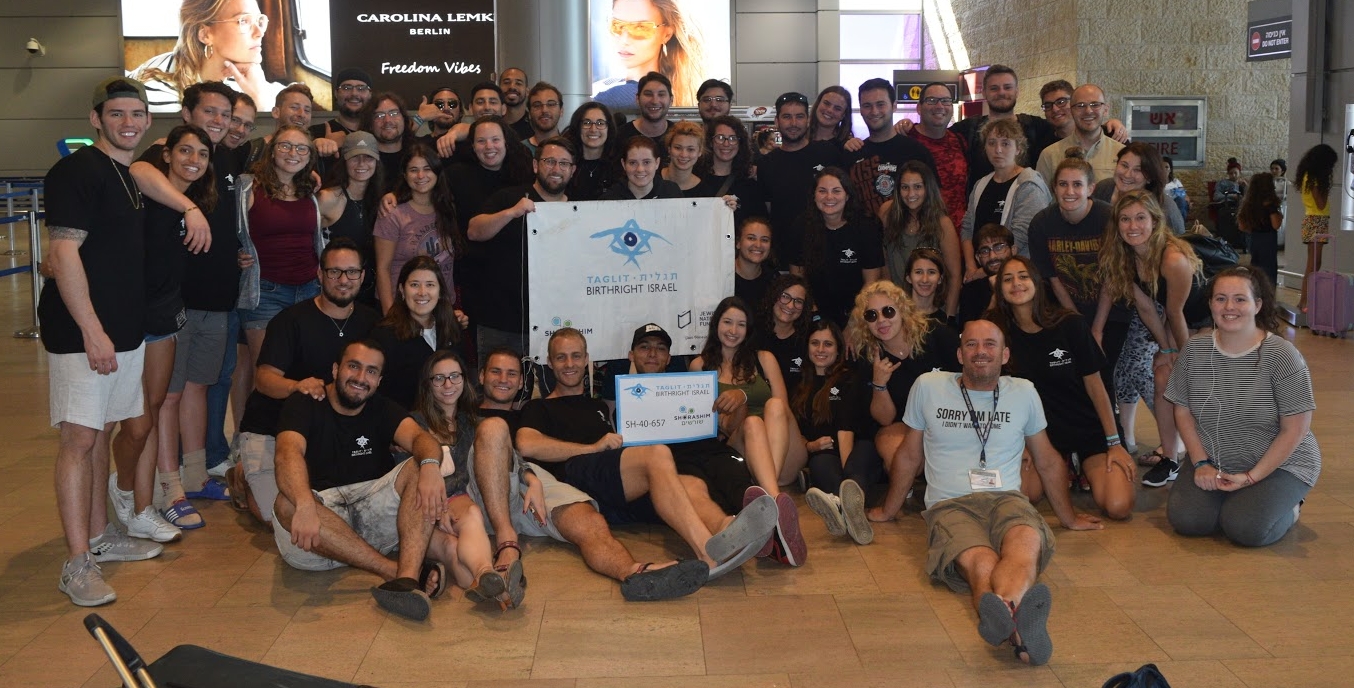
Day 1 - Afik Kibbutz Orchan and Shehecheyanu Ceremony
We were greeted at the airport by our Israeli participants and our Israeli guide, Itamar Bouton, who would prove himself to be an enthusiastic, knowledgeable and humorous leader over the course of the trip. He gave three simple rules to follow: don’t be stupid, don’t be a jerk, and don’t be late!
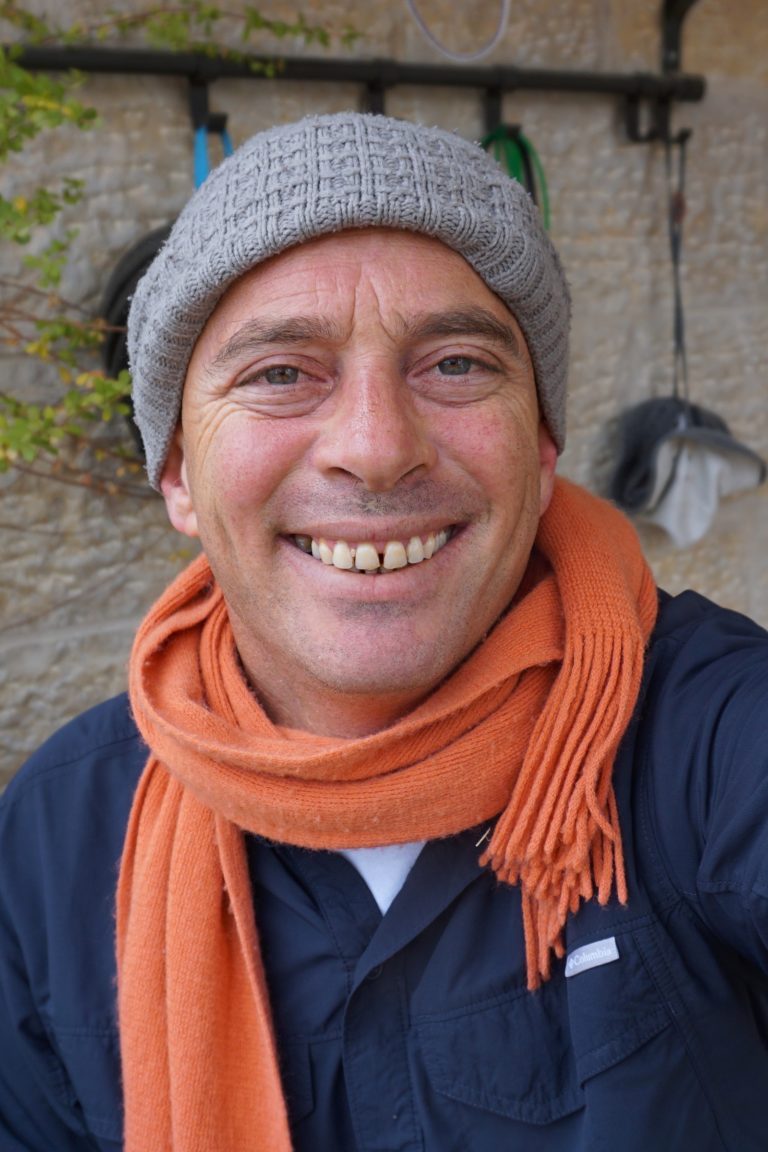
We immediately left Ben Gurion airport in Tel Aviv, heading Northeast to an Israeli settlement in the Golan Heights called Afik, where we spent the first two nights at our first Kibbutz. Unbeknownst to me at the time, Wikipedia states that the kibbutz is the first Israeli kibbutz in Golan Heights and is considered an illegal settlement under international law. I was unable to learn when the kibbutz was established, but the Jewish Virtual Library suggests that kibbutzim in the Golan Heights predate Israeli control, although no kibbutz was in Afik prior to Israel capturing the Golan Heights during the Six Day War.
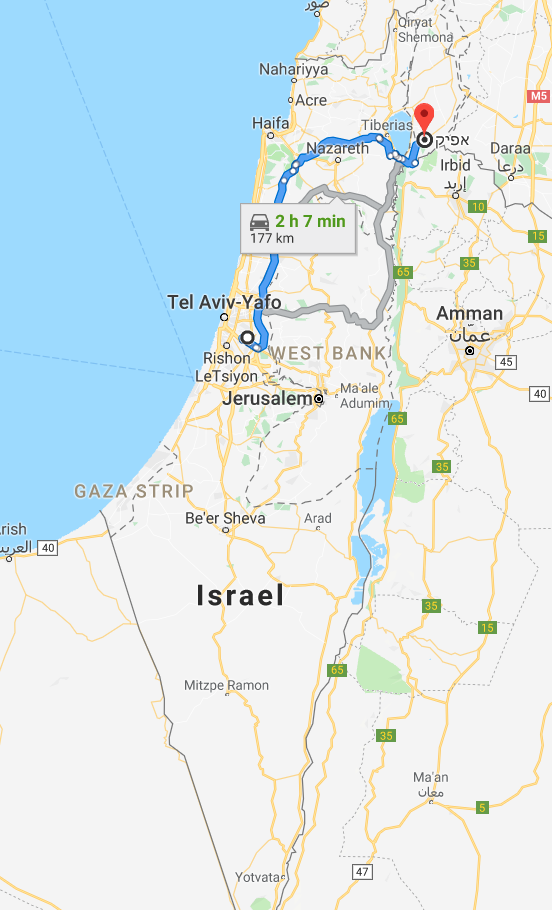
The kibbutz was lush and gorgeous. I was surprised to learn that the history of kibbutzim in Israel is closely intertwined with Marxist/Communist elements; one of the pioneers wrote that, “We were happy enough working on the land, but we knew more and more certainly that the ways of the old settlements were not for us. This was not the way we hoped to settle the country—this old way with Jews on top and Arabs working for them; anyway, we thought that there shouldn’t be employers and employed at all. There must be a better way.” Decisions are made communally and (at least historically) resources and chores were shared. The captial necessary to purchase land came in the form of small donations from Jews across Europe.

Our guide Itamar gave us a preview of where we would travel and what we would do over the course of the trip, using Ben as a makeshift map of Israel. To get to know one another, we played an activity where we partnered up and told our partner an embarrassing story that we felt comfortable being shared with the group; we then went around the circle, introducing our partner and his or her story. Most of the stories were tame, but one pair missed the detail about their stories being shared with the larger group, so they told one another their most embarrassing stories. Sadly, neither gave me permission to share their stories.
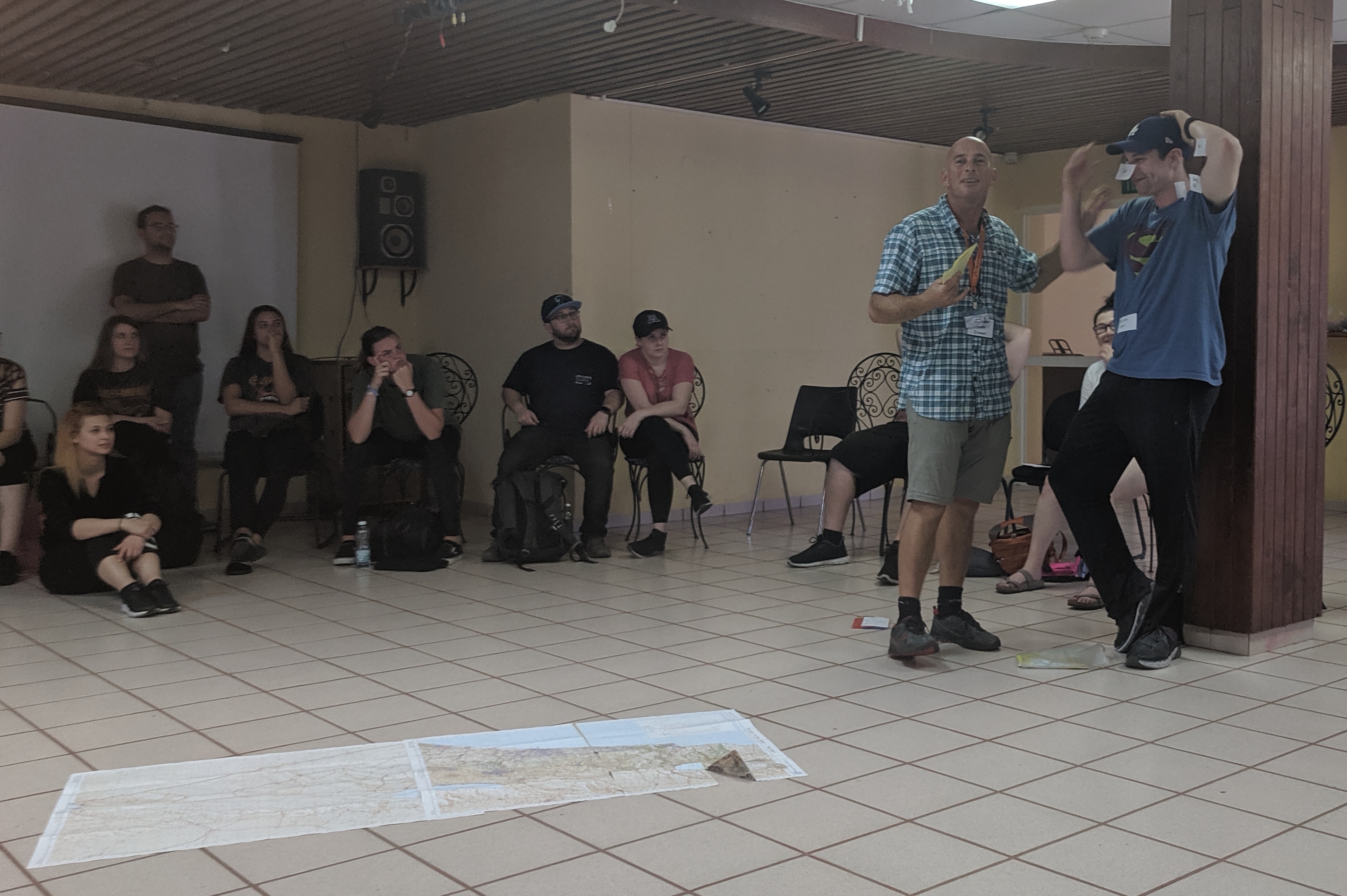
The final activity of the day was the Shehecheyanu during sunset. Shehecheyanu is a common Jewish prayer used to celebrate new experiences. Most significantly and recently, the Shehecheyanu was recited by Israel’s first Minister of Religions, Yehuda Leib Maimon, in 1948 after the first Prime Minister read Israel’s Declaration of Independence.
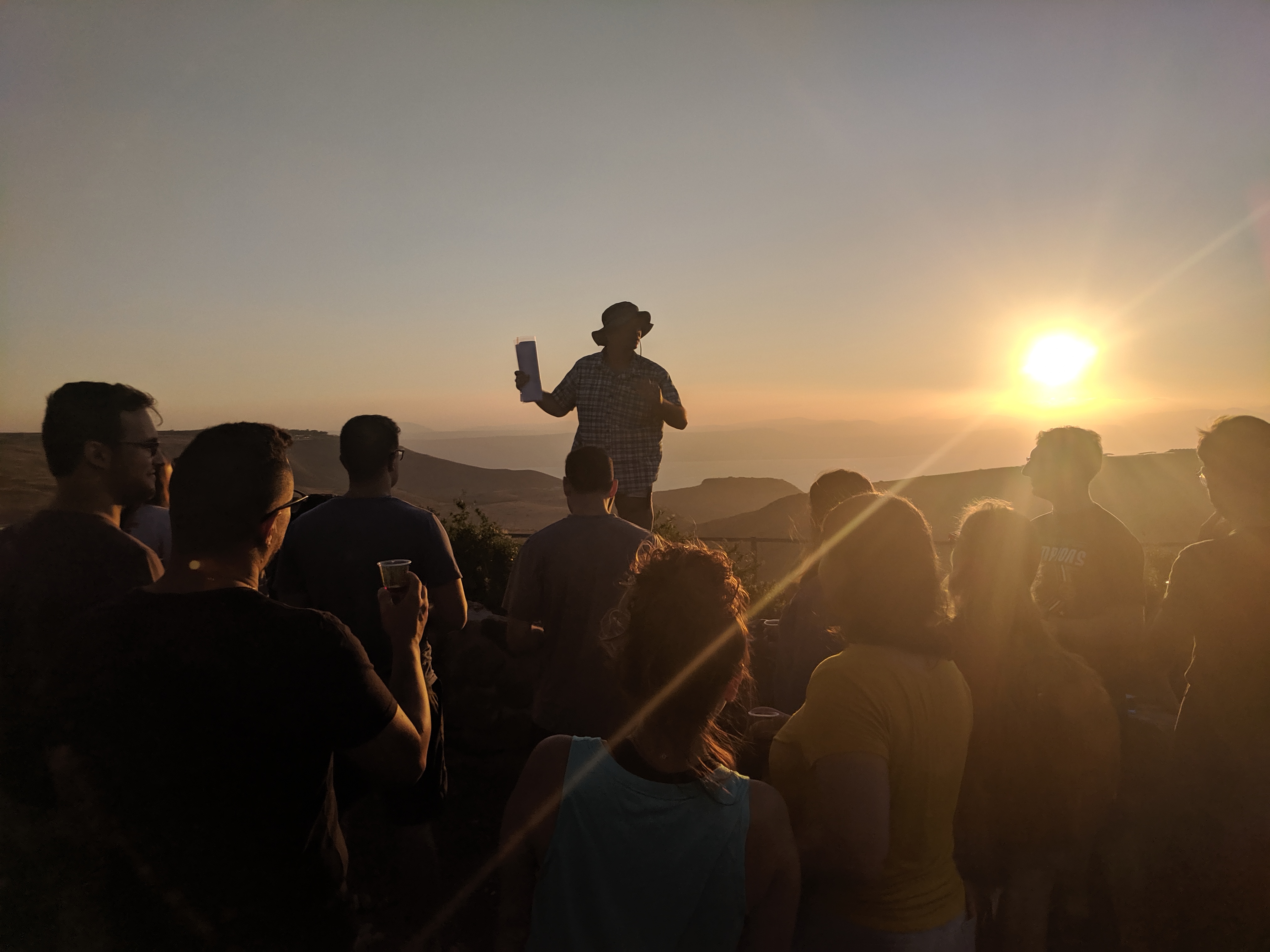
Day 2 - Hiking, Golan Heights and Rafting
On Day 2, an 18-year old Israeli named Dvir Sorek was killed by two Palestinians, one who was a member of Hamas, a constant reminder of the security challenges facing Israel. Sorek was stabbed to death in his West Bank settlement of Migdal Oz, where he was a seminary and military student. His body was discovered the next morning and his killers were captured alive within three days. Hamas claimed that the attack was retaliation for Israeli destruction of Palestinian residential buildings in late July 2019. Over breakfast, we asked one of the Israelis traveling with us for her perspective regarding Palestinians and the Israeli Defense Force (IDF), and one comment she made stuck with me: she claimed that the IDF is exclusively a defense force and as justification, she emphasized that the word “defense” is the “D” in “IDF.” A disappointing answer. Days later, I would learn that she herself is from a West Bank settlement called Adora, which was attacked during the second intifada. Four of her townspeople were killed when two attackers dressed as IDF soldiers, cut through the security fence and went house to house shooting children while families were praying for Shabbat. One of the dead was a young girl close in age to my Israeli companion. An attacker was later released as part of a trade for an IDF prisoner of war.
We started the day with a hike. Halfway through, we encountered a delightful pond that we went swimming in. Our wet clothes proved to be a good defense against the growing heat of the day.
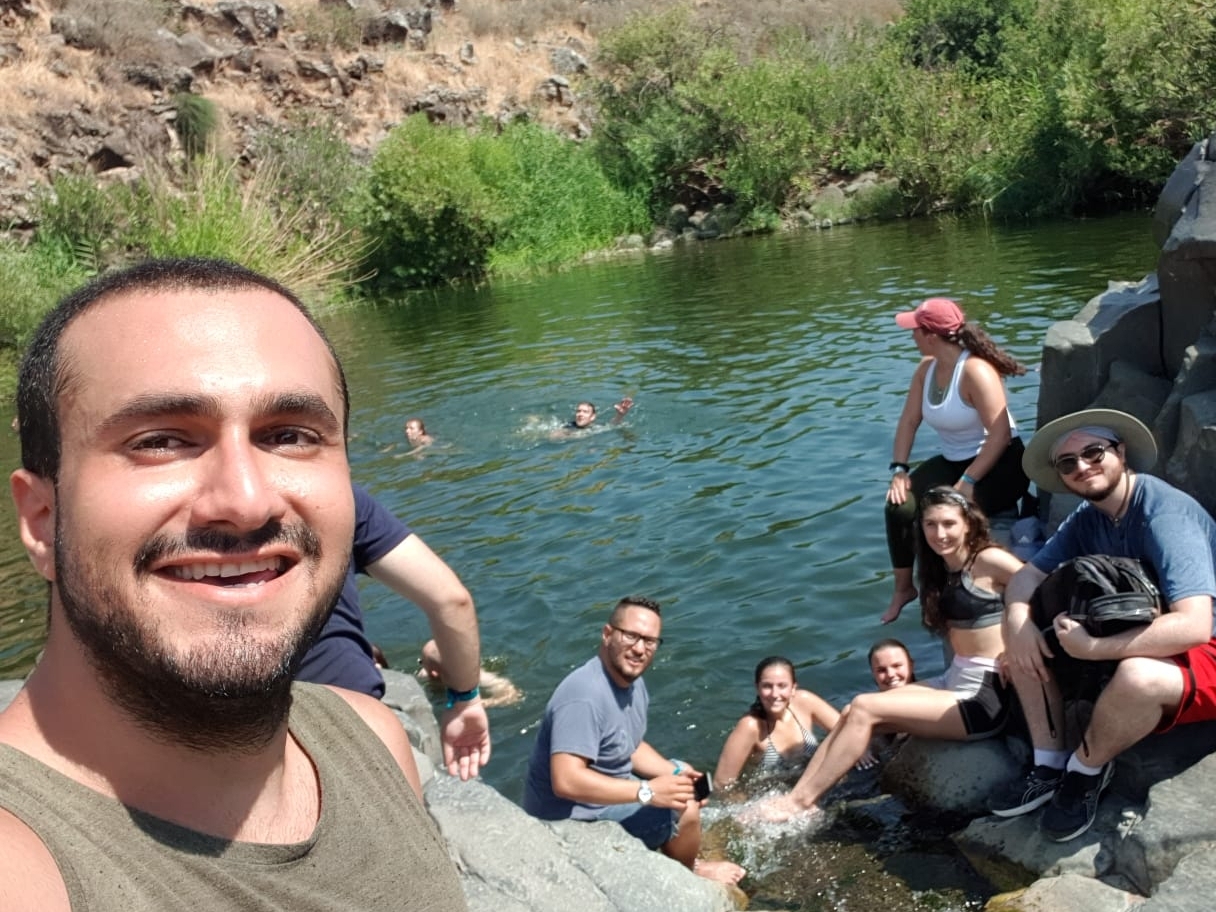
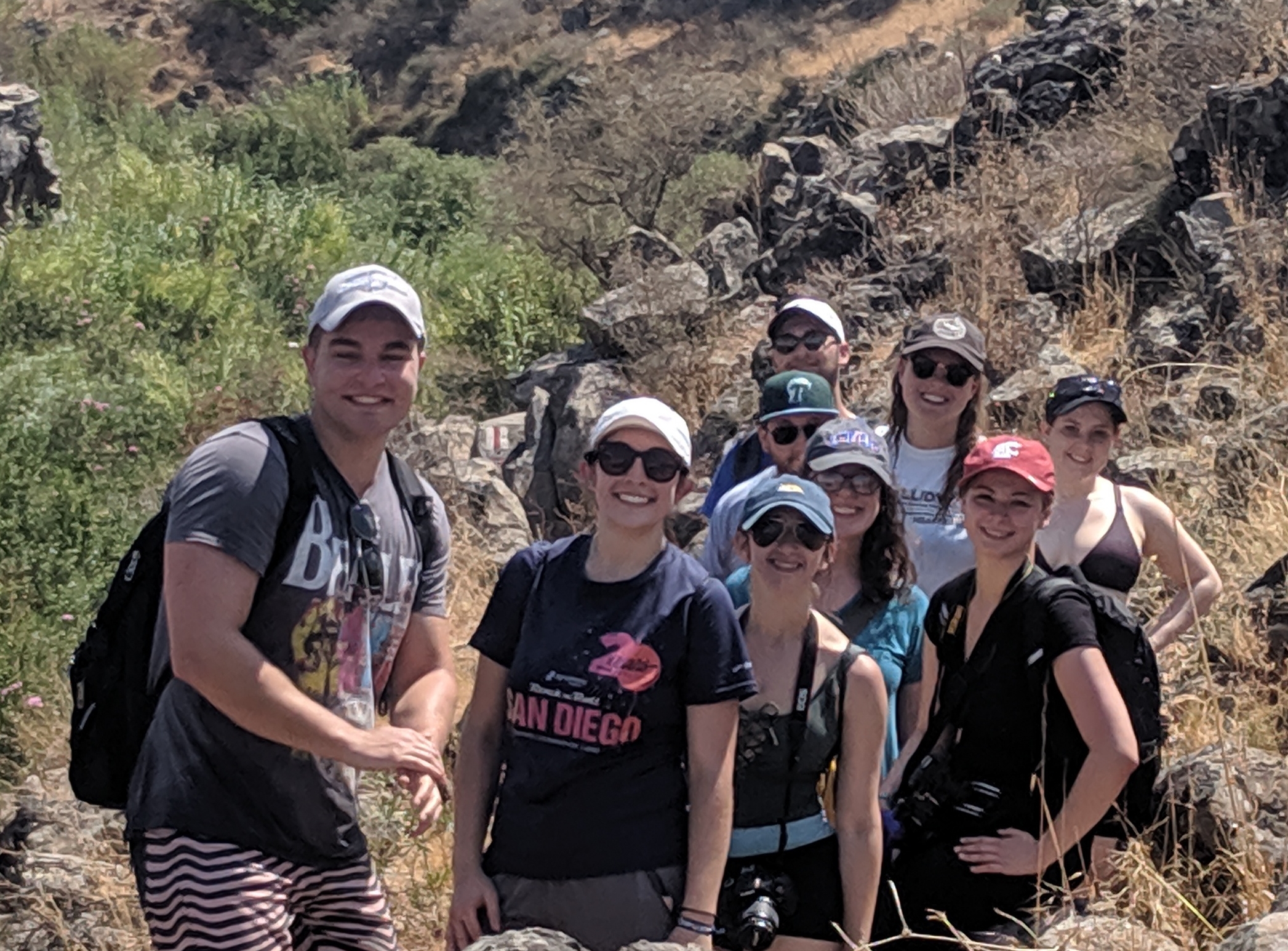
As we passed over diverse types of rocks, we learned that the Golan Heights was formerly seismically active. Consequently, mountains were formed that act as a watershed funneling clean rainwater into the Sea of Galilee, where it can be used for drinking and agriculture. This clarified why Israel is so determined to hold onto the Golan Heights; in a war, Syria could cut off roughly 10% of Israel’s water supply, and indeed, the Arab League tried to do exactly that leading up to the Six Day War.

Our final activity of the day was rafting. There was only one short section of the river that wasn’t calm, but Becca, Dani, Nate and I entertained ourselves by chasing other rafts, throwing people out of their rafts (sorry Danny!) and attempting to paddle while facing in opposite directions.
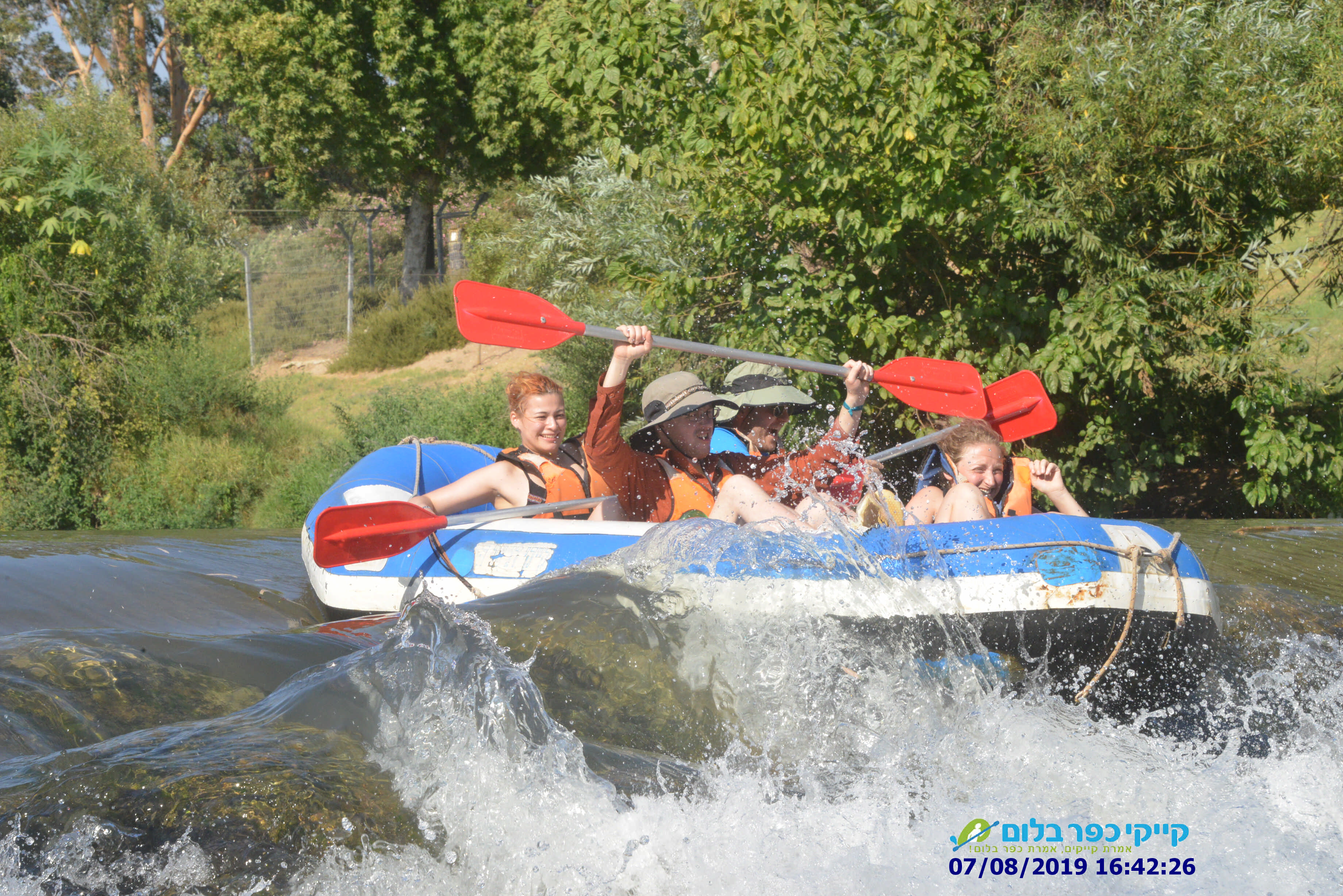
Day 3 - Tzfat and the Kabbalah
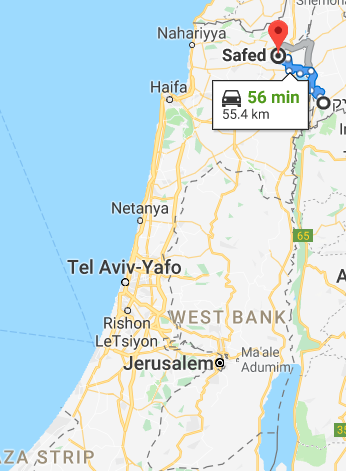
Day 3 started with a bus ride to Tzfat (also known as Safed), one of the four holiest cities in Israel, the others being Jerusalem, Hebron and Tiberias. Each of the four is considered for a different reason. Jerusalem is paramount for its selection by King David as the site of the Holy Temple. Hebron, the believed burial site of the Jewish Patriarchs (Abraham, Sarah, Isaac, Rebecca, Jacob and Leah) is secondary. Tiberias is significant for two reasons: first, Tiberias is the location where the Talmud was first recorded from oral traditions; second, Tiberias
Why Tiberias and Tzfat are considered holy escapes me, since neither seems to have hosted any significant spiritual event.
Our first stop was the Tzfat Gallery of Mystical Art, an art gallery run by a former American named Robert who made Aliyah (i.e. emigrated) to Israel and took the name Avraham Loewenthal. Apparently we were running behind schedule and there was another group after us, so he hurriedly attempted to explain to us the core concepts of the Kabbalah and how his art attempts to communicate those concepts visually. Before arriving, I asked one of the Israelis on the trip to explain what Kabbalah is and he said that the closest American concept is spiritual hippies, which I found apropos upon meeting Avraham. Kabbalah is an old interpretation of Judaism that took its modern form in the 16th century, when Sephardic Jews were expelled from Spain and relocated to Tzfat in Israel; their painful experiences led them to focus on the Jewish Messiah, a prophesied figure who would deliver the Jewish people from suffering.
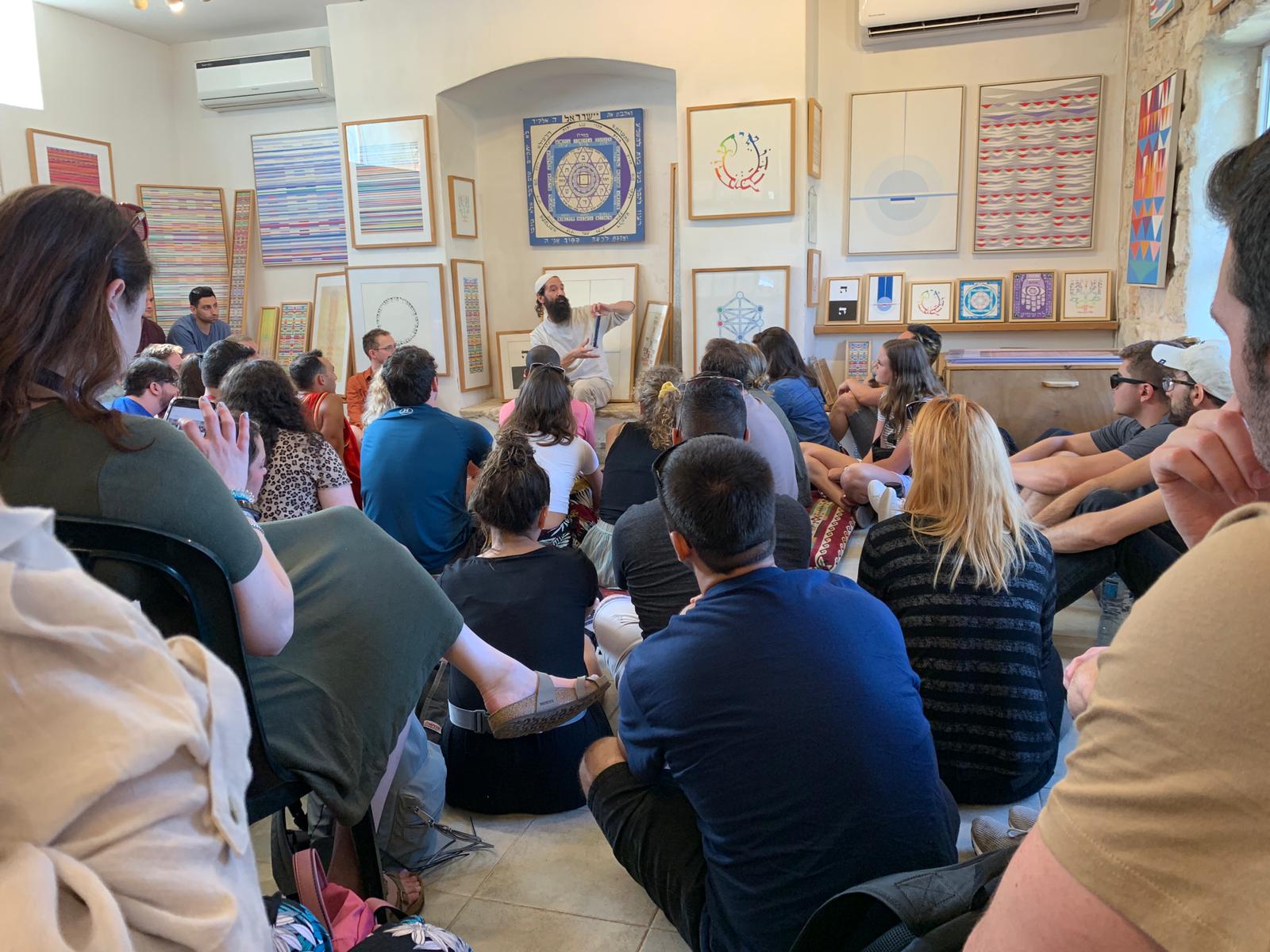
Avraham’s explanation of core Kabbalah beliefs differs significantly from the Wikipedia article, so I’m not sure where exactly the truth lies. Avraham stated that Kabbalah holds that the world involves giving and taking, and that virtue stems from maximizing giving and minimizing taking. I asked whether his ideal world, in which everyone gives and no one takes, is necessarily contradictory. In response, he gave me a printout to read to resolve the apparent paradox, but the printout didn’t seem relevant to the question. He also told us that Kabbalah believes in a sacred tie between a person and their name, and that adopting a new name when making Aliyah can feel like a transcendental moment. Many people in our group bought small copies of his art work.
After leaving Avraham’s art store, we walked through the old Jewish quarter of Tzfat. Itamar shared with us the story of how Israel came to control Tzfat. As the British and French prepared to leave the Middle East, the UN Partition Plan for Palestine allocated for the Jewish people, but the city itself was home to 1700 Jews and 12000 Arabs. To make matters worse for the small Jewish population, they were poorly armed in comparison and lacked control over strategic areas of the city. However, the Jews were able to obtain an artillery weapon called the Davidka that was terribly inaccurate but frighteningly loud. Somehow, a rumor started amongst the Arabs that the Davidka was an atomic bomb and the Arabs fled from the city, ceding it to Jewish control.
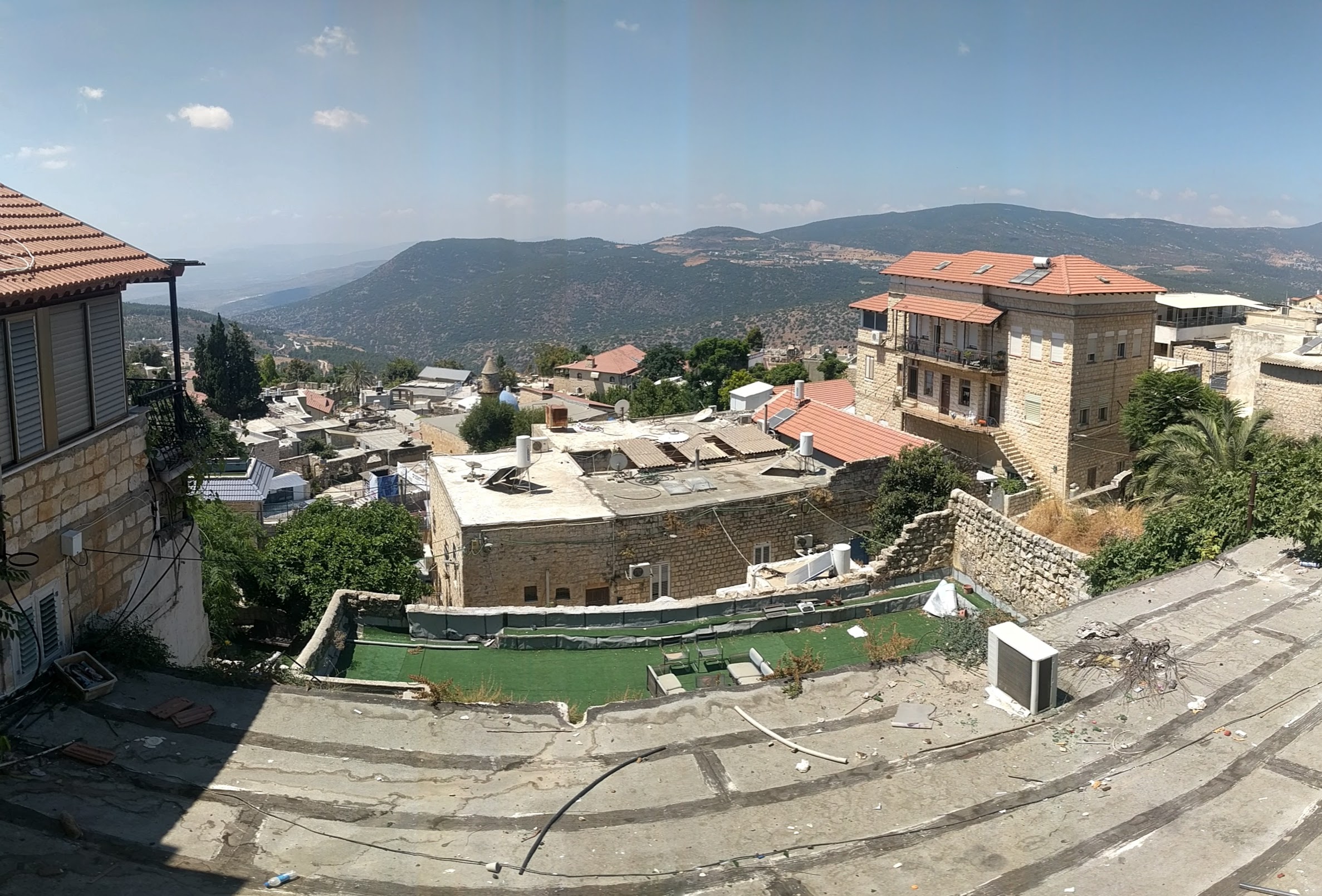
The group was given two hours to shop for souvenirs, so Dani, Nathan and I seized the opportunity to explore the city. We walked through streets that looks hundreds of years old, past citizens who looked equally dated, until we accidentally encountered the modern part of the city. It turns out the quarter we had been in was a small historical area and that the majority of the city does not live like that. One of the locals we met (right) laughed at us for thinking that the historical district is representative of the city. He also joked that I must be a professor since I asked so many questions.
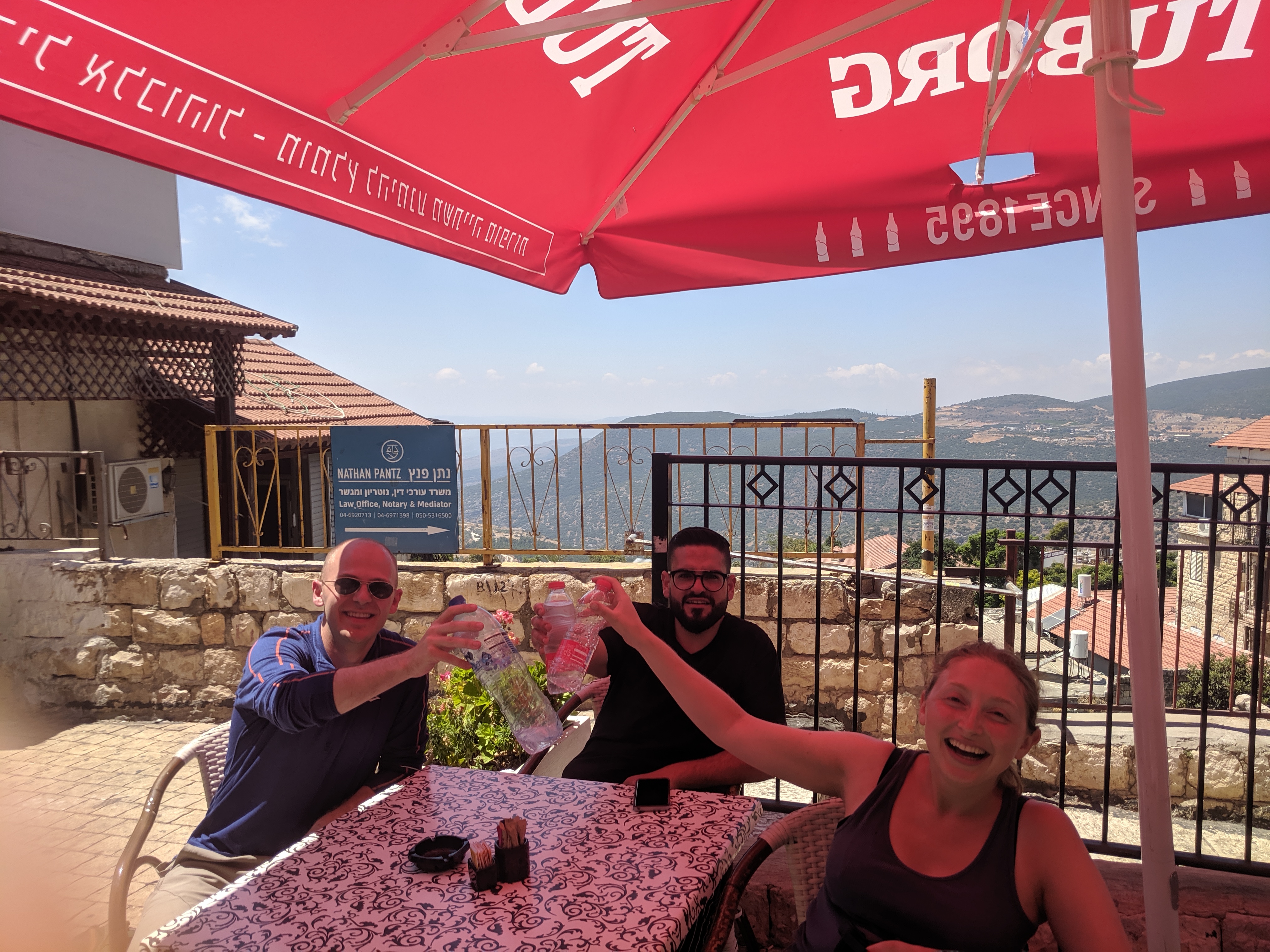
Day 4 - Knesset Menorah, Israel Museum and the Western Wall
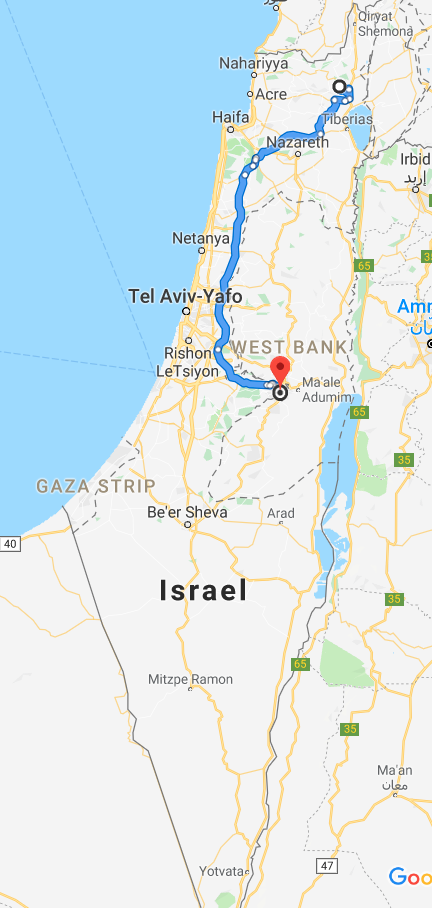
Day 4 started in Jerusalem at the Knesset Menorah, a 15 foot tall Menorah located near The Knesset (Israel’s Parliament). I might not have been listening since it was only when I read the Wikipedia article that I learned that this menorah isn’t some unimportant sculpture. It was a gift from the British Parliament and each branch portrays different stories of the Jewish people. The branches are not chronologically ordered, but are rather arranged to reflect thematic symmetry. The central branch displays the most important stories, including the 10 Commandments as given to Moses on Mount Sinai and Israel’s War for Independence that create the state of Israel. I wasn’t familiar with most of the stories on the menorah; the whole Wikipedia article is worth a read.
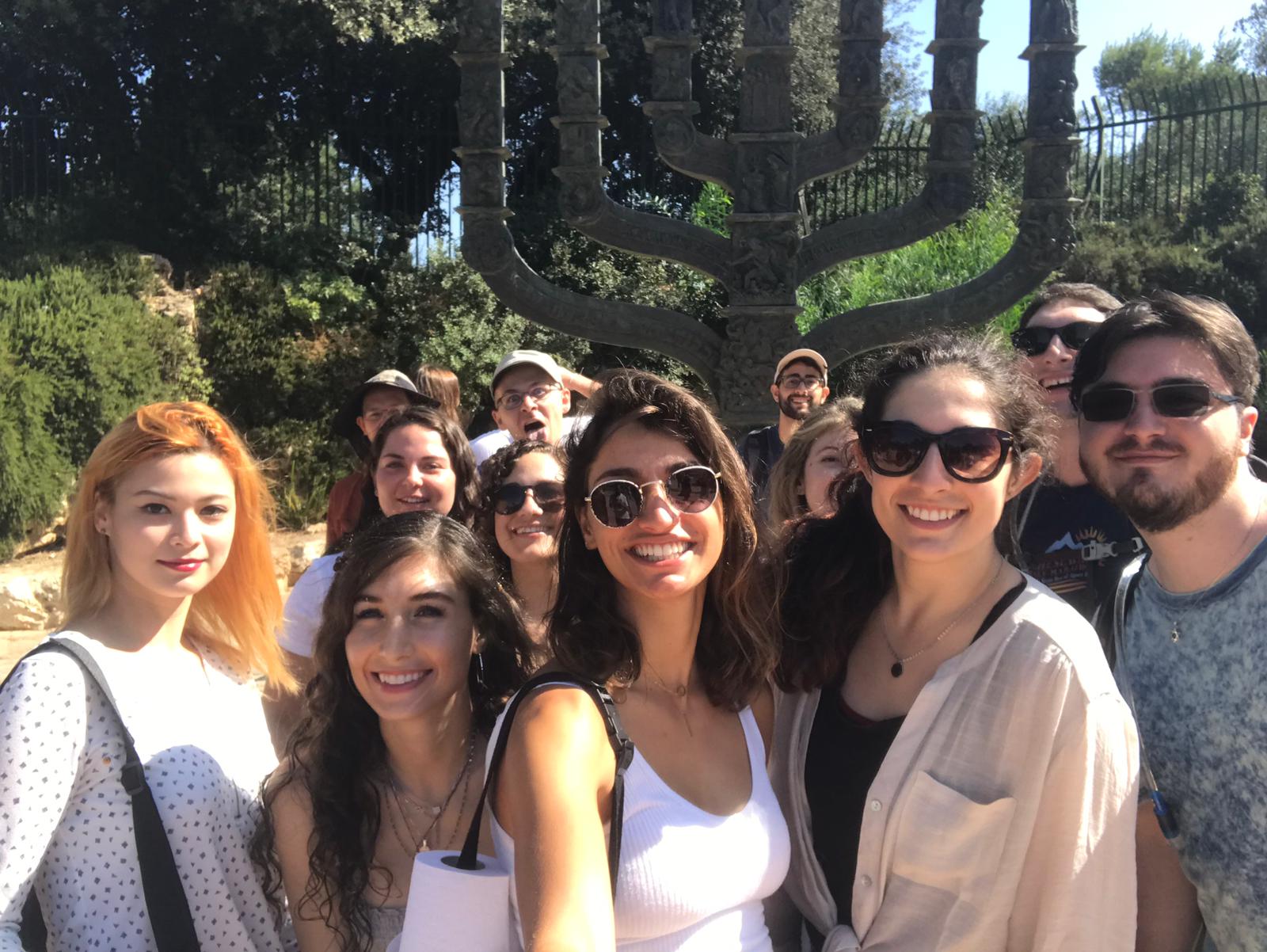
We then visited the Israel Museum of Jerusalem. Several exhibits were interesting. The first was a 50:1 model replica of the Second Temple, the holiest site in Judaism. Architecturally, the Temple is structured hierarchically and individuals were limited in where they could go based on their religious seniority. For instance, the outer forecourt was open to all men, women and children, whereas only men were allowed to enter the Court of Israel and only (male) rabbis were permitted to enter the Court of the Priests. The highest place of the Temple, the Holy of Holies, was forbidden for all, except on Yom Kippur when the Chief Rabbi would enter with rope tied around his ankles, to be pulled out should anything happen to him. The Temple was destroyed during a Jewish revolt against the Roman Empire. One point that’s unclear to me is whether the Jews were responsible for destroying the temple; evidence seems to suggest that Jews started a fire to ward off Romans that did the majority of the damage. This event is the motivation for Tisha B’Av, an annual day of fasting to lament the loss of the First and Second Temples.
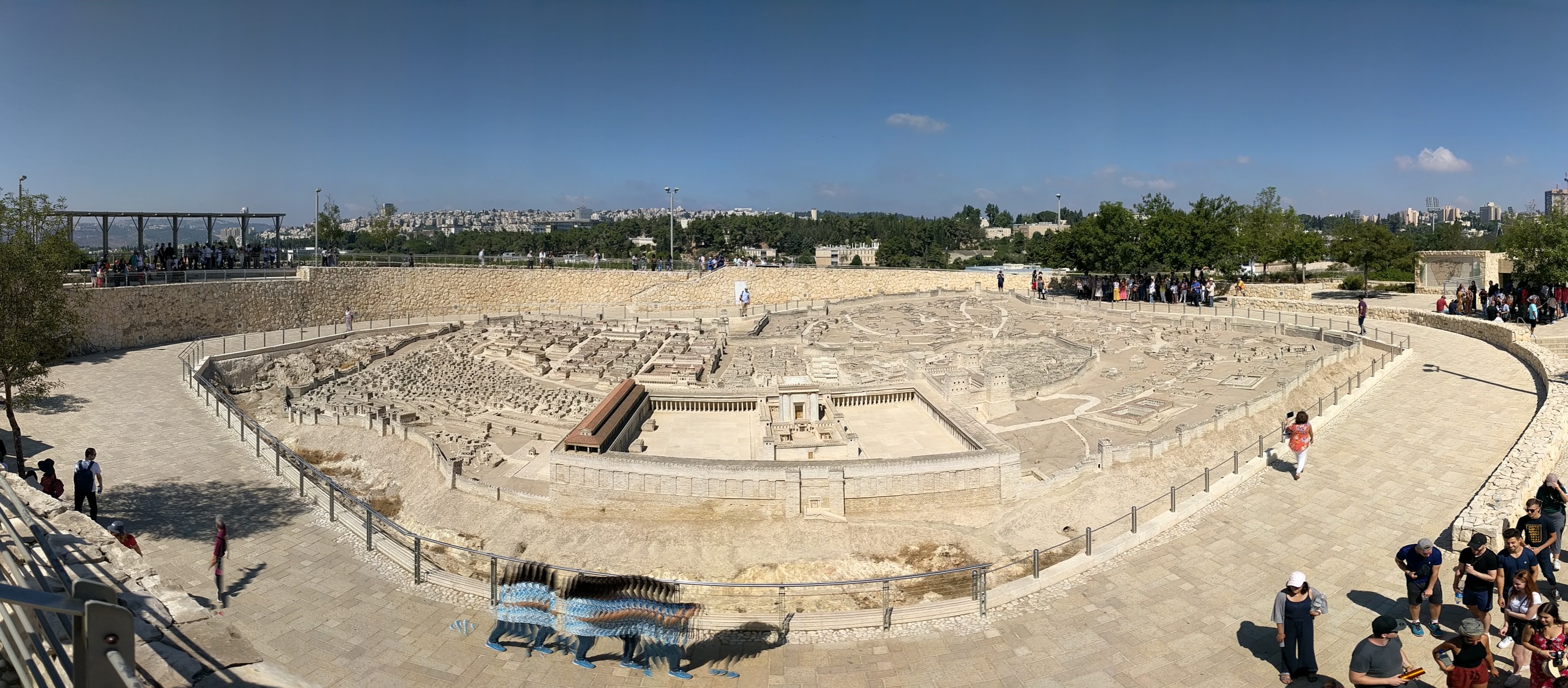
Many people’s favorite exhibit was the Dead Sea Scrolls, a set of religious manuscripts dated as early as 300 BCE, but I found the exhibit uninformative and uninspiring. The exhibit focused on where the scrolls were found, how the scrolls were preserved and what we know about the authors of the scrolls. My favorite exhibit concerned the Israeli astronaut Ilan Ramon, who was killed when Columbia exploded on re-entry. A secular Jew, Ramon flew to space with a number of moving personal objects including a pencil sketch titled “Moon Landscape” drawn by a 16-year old boy who died in Auschwitz and the US Declaration of Independence. The most powerful story concerned a miniature Torah scroll Ramon carried. Ramon was given the scroll by Joachim Yosef, a professor of astrophysics and climate science, who himself obtained the scrolls from the Rabbi who performed his Bar Mitzvah at the Bergen-Belsen concentration camp, Shimon Dasberg; Dasberg gave Yosef the Torah scroll, fearing that he would not survive. Ramon asked Yosef for permission to take the scroll to space as a testament to the ability of the Jewish people to rise from the ashes and break the barriers of human capabilities. I thought of Gus Grissom, one of the earliest astronauts to die in America’s space program, who years before his death comforted our country by saying, “If we die, we want people to accept it. We are in a risky business and we hope that if anything happens to us it will not delay the program. The conquest of space is worth the risk of life.” I imagine Ramon felt similarly.
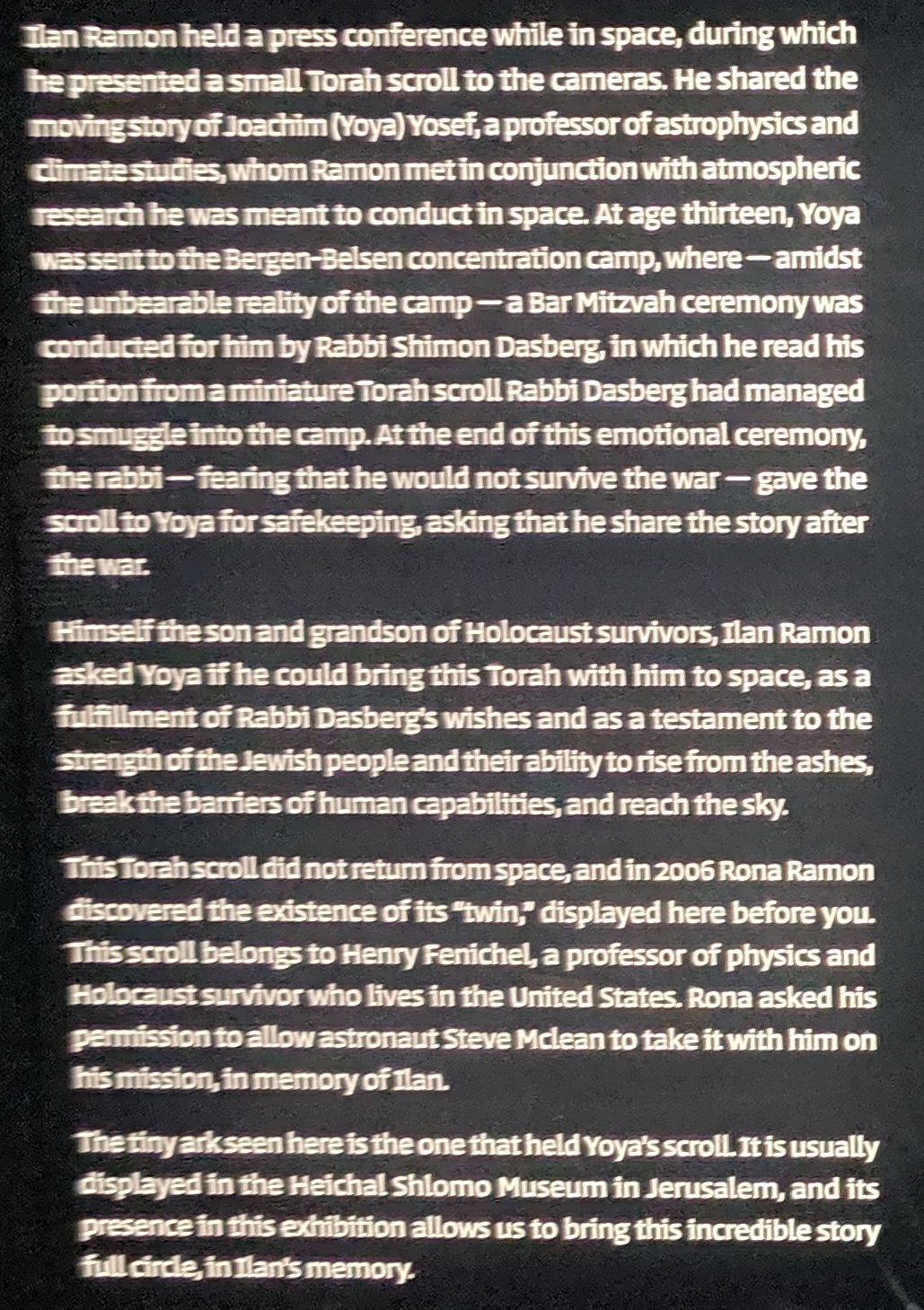
People on the trip worked hard to get just the right shot!
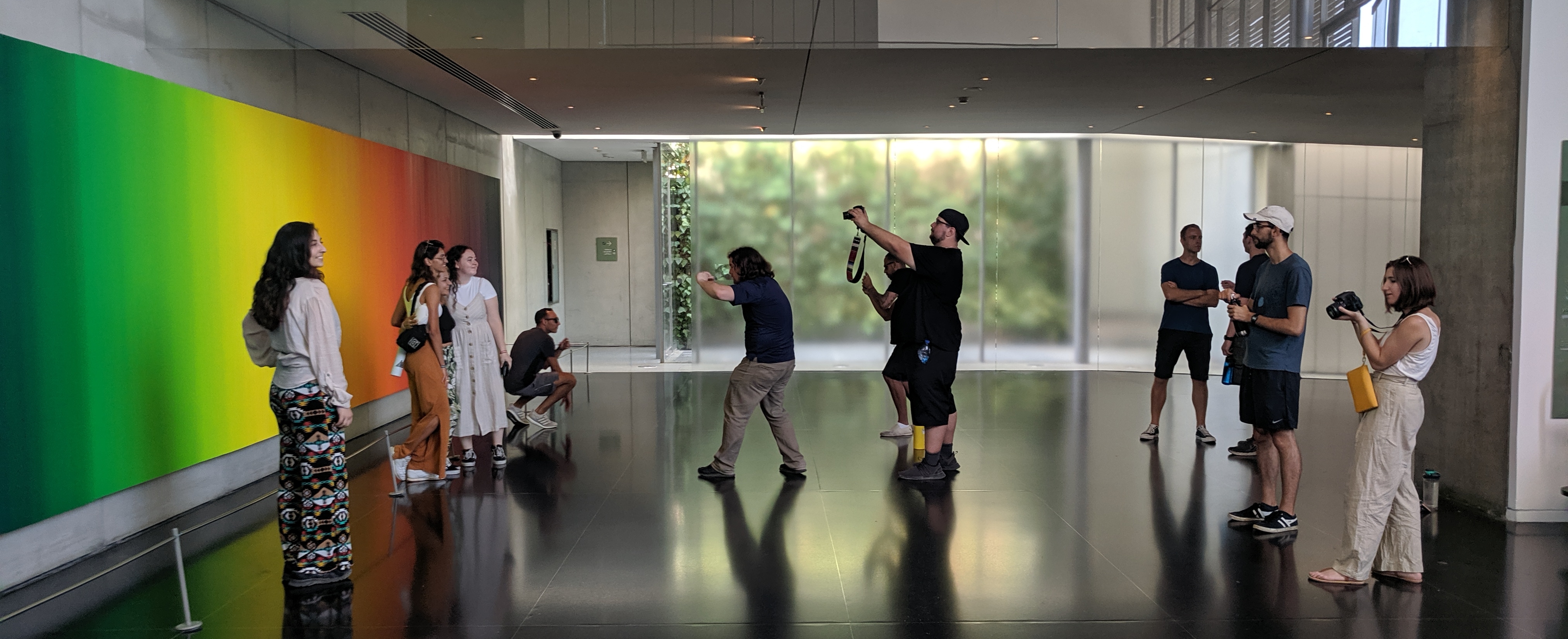
Our final stop of the day was the Western Wall. We were afforded the chance to leave a prayer at the Wall and many did. I repeatedly tried and failed to write a prayer that I wouldn’t be ashamed of, until I remembered a question Mark Twain once asked. The prayer I left read “To the sinner that needs a prayer the most: I struggle to find the words to express how I feel, but I hope that your world turns for the better and that you find what you need.”
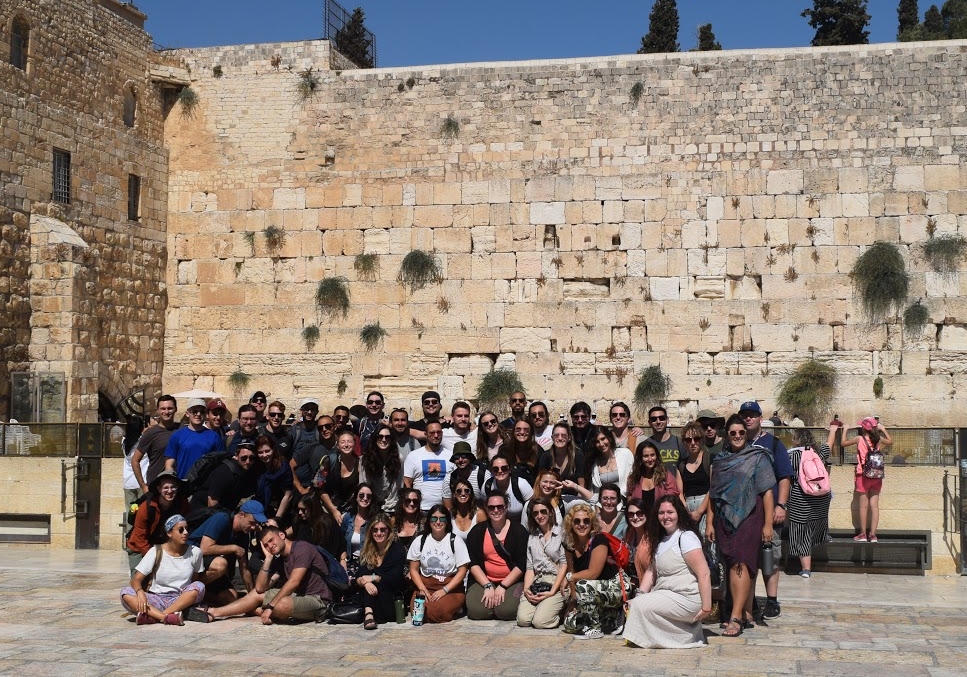
Day 5 - Jerusalem, Ein Karem and B’nai Mitzvah
Day 5 started in Jerusalem on Shabbat. We were given the whole morning off, so Dani, Nathan and I set out to explore the city. We were amazed at how quiet the city was. Not a shop was open, not a car moved, not a person was in the street other than Orthodox Jews walking in heavy black coats and wide black hats.
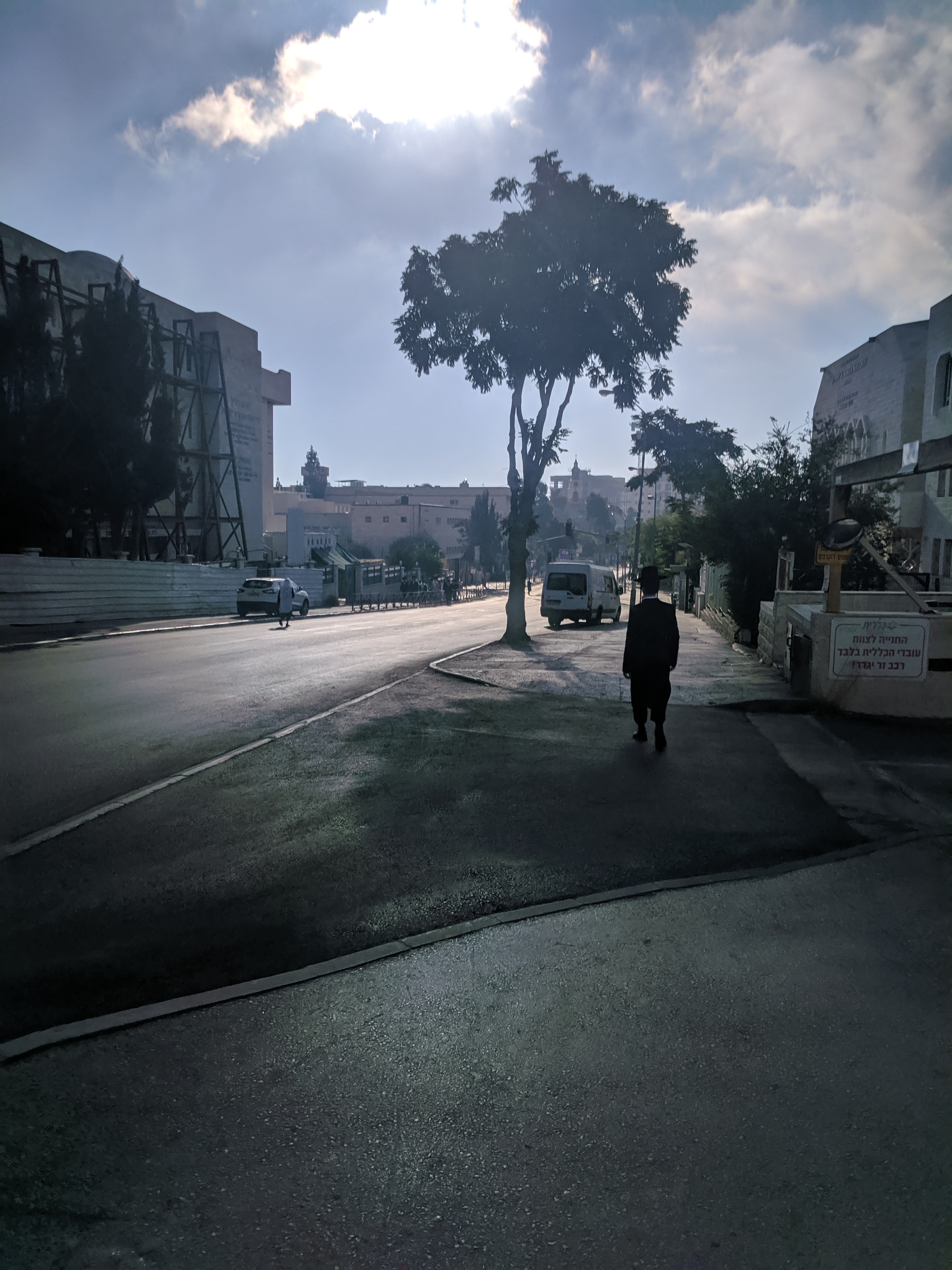
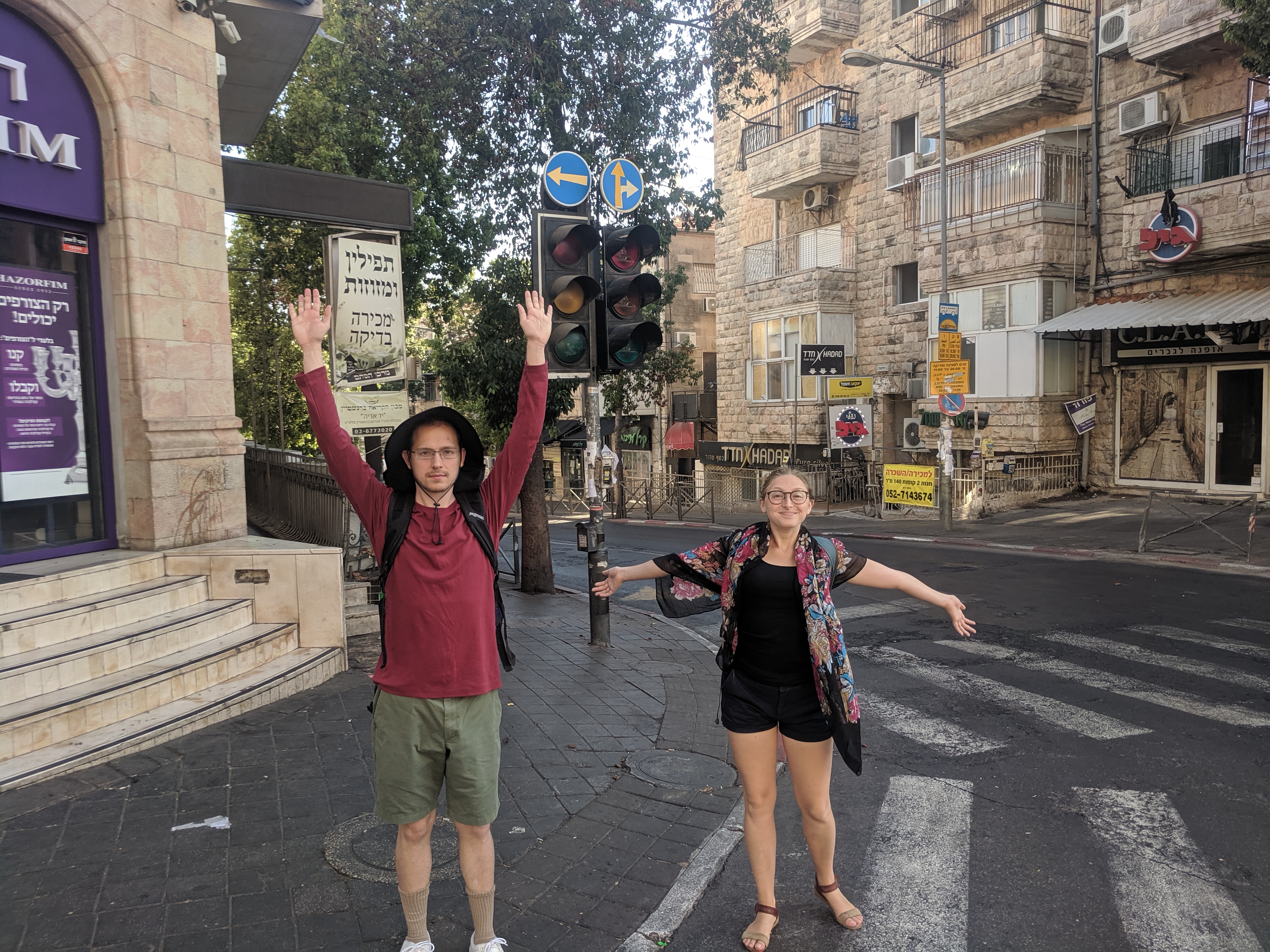
As we walked through the street, we passed by a large white pop-up tent, almost like what I’d expect from a Midwest Evangelical traveling ministry. One Rabbi approached us and asked, in broken English, whether any of us were not Jewish. I figured since I was on Birthright I should say yes, so I did, but Dani said no and Nate followed her lead. The Rabbi then asked Nate if he could help with something; Nate disappeared behind the large white tent. While I waited, I had an awkward broken conversation with the remaining students. Eventually, Nate returned and we asked him what had happened. Apparently, there was some eletrical box used to control elements (lighting, curtains, etc.) of the prayer, but that the electrical box had broken and needed to be reset. The fix was trivial - press the reset button - but the Orthodox Jews were prohibited from using technology on Shabbat. He said that there were three or four grown men around the box, fretting how service might be impacted without a fix until he showed up to press the button.
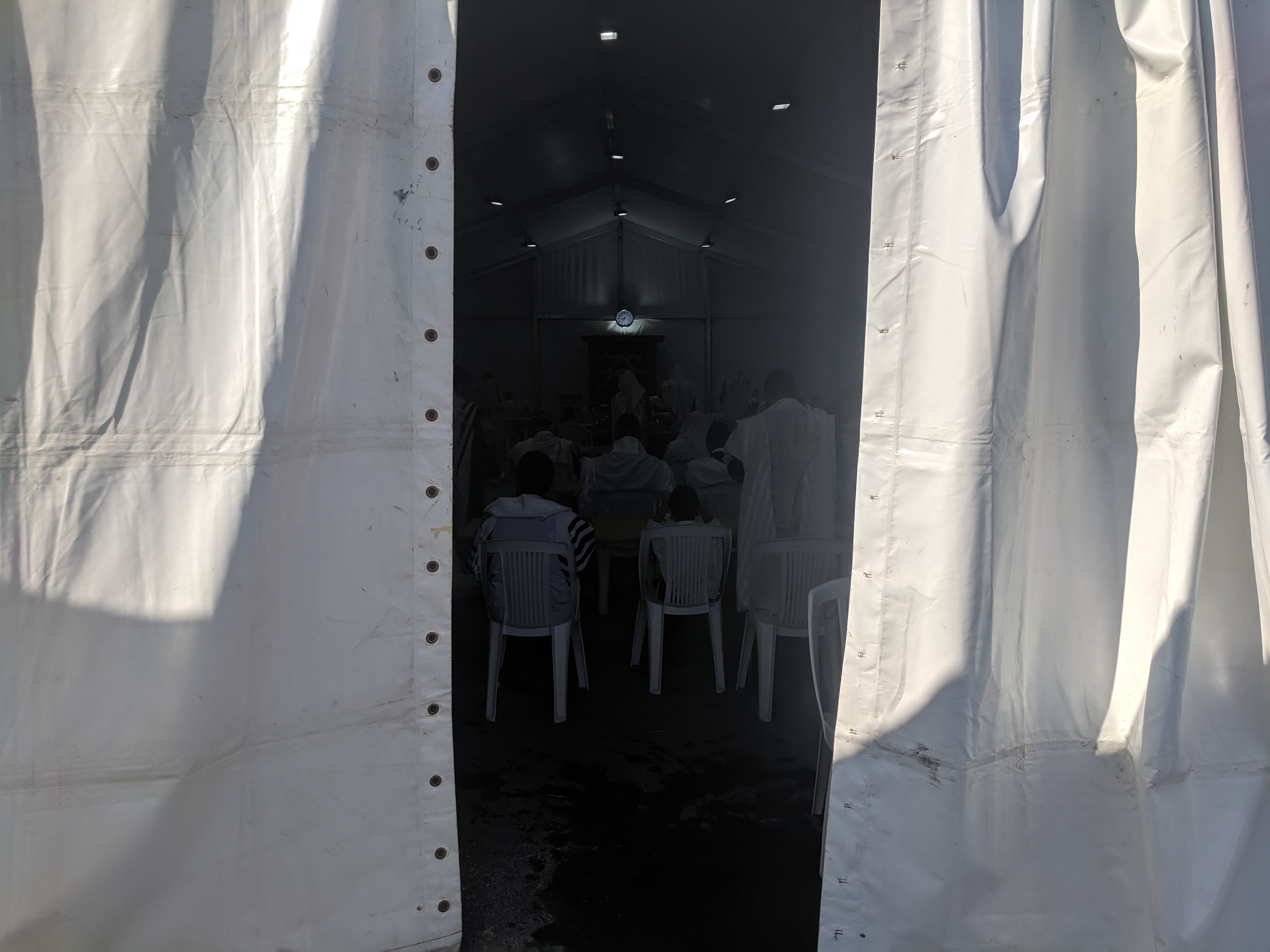
We continued on through a Muslim quarter of Jerusalem towards our goal of the Hebrew University of Jerusalem, which I wanted to see for its world-class Brain Sciences departments. As we walked through the Muslim quarter, we noticed a couple things. First, probably 1/4th of all shops were auto-repair shops; we tried asking locals why there were so many, but the only answers we received were “to repair cars.” Second, local corner shops sold cleaning supplies in bottles that looked like common sugary beverages (imagine Arizona Ice Tea crossed with Gatorade), without any English text indicating that the fluid was not to be drunk. We eventually reached Hebrew University of Jerusalem.
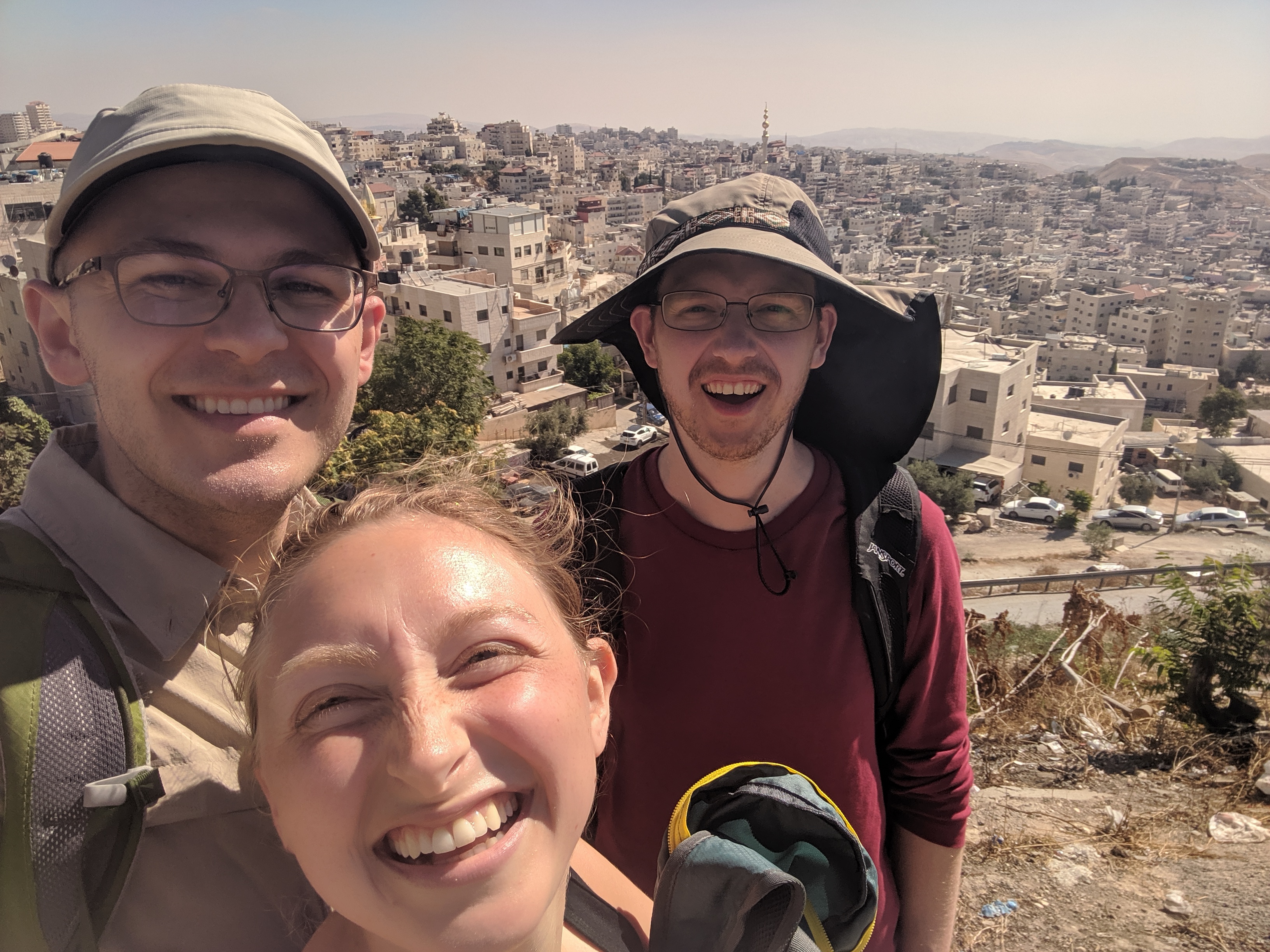
Unfortunately the entire campus appeared closed for Shabbat. By reading murals on campus, I learned that Hebrew University predates the state of Israel. It was formed in 1913 when the 11th Zionist Congress voted in favor of establishing a university for Jewish learning and construction started in 1918. During the 1948 War of Independence, the University was forced to relocate, but returned in 1967.
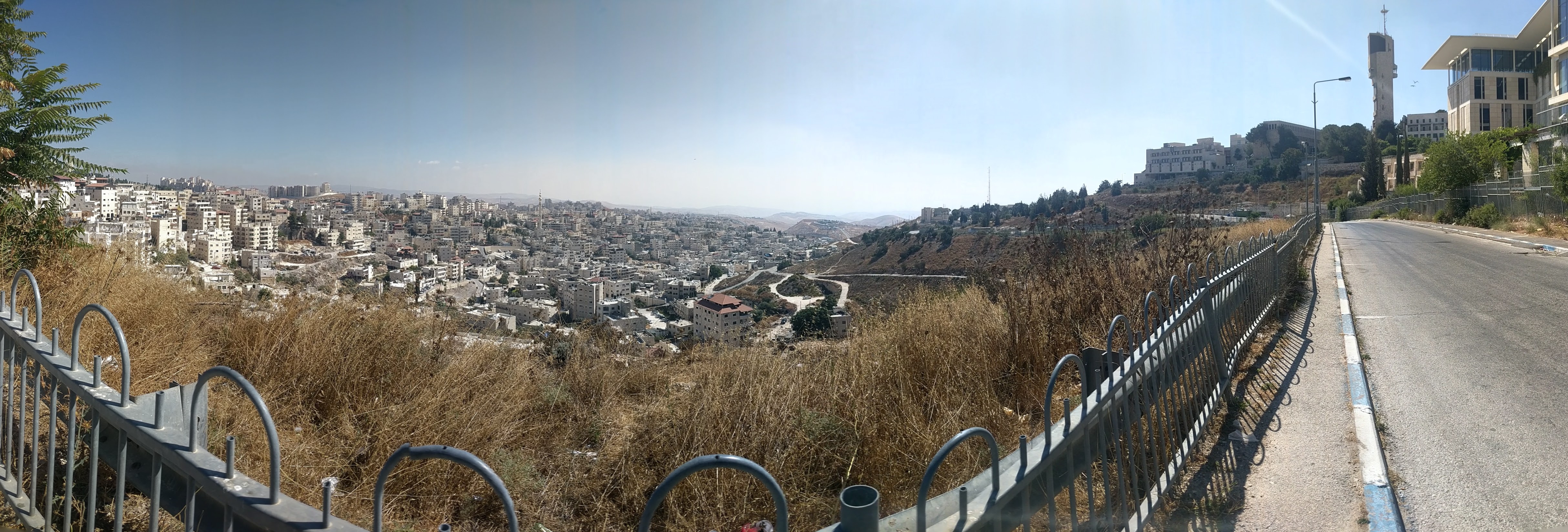
We then took a Gett taxi (the Israeli equivalent of an Uber or Lyft) to Ein Karem at the recommendation of one of our Israeli friends. I struck up a conversation with our driver and learned that he has lived in Jerusalem his entire life, working first as a driver for tourists going to the Dead Sea and then as a taxi driver in Jerusalem. He told us that what he loves most about Jerusalem is the natural beauty - he took us on a scenic route around the city, pointing out the surrounding hills. He suggested we start exploring Ein Karem at its mosque, promising us clean water to refill out canteens; we took him up on his suggestion only to discover the mosque appeared abandoned and its water labeled “not for human consumption.” The town was small, but modern. We stopped at an ice cream/gelato shop that was delicious. Nate swears that their date/pecan sorbet is some of the best ice cream he’s ever had.
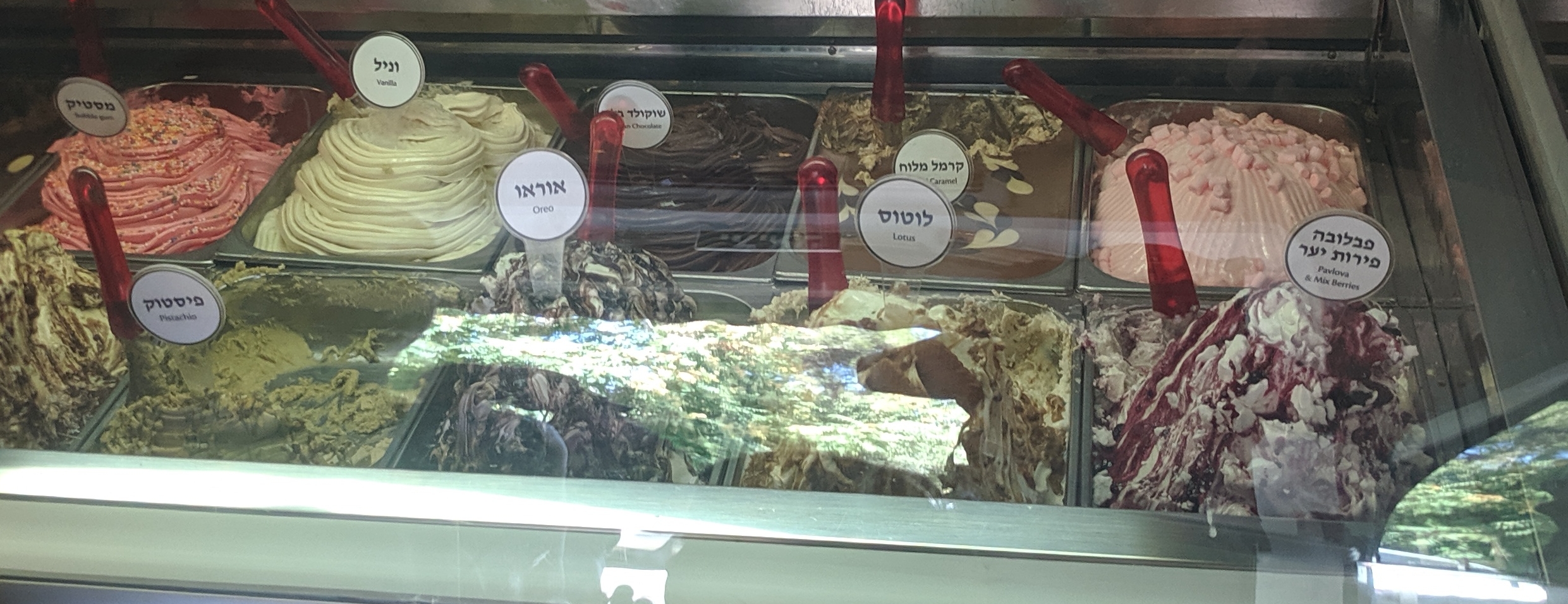
We also discovered fried chicken on a family’s rooftop, placed in a way that suggested they were using the sun and ambient heat to keep their chicken warm.
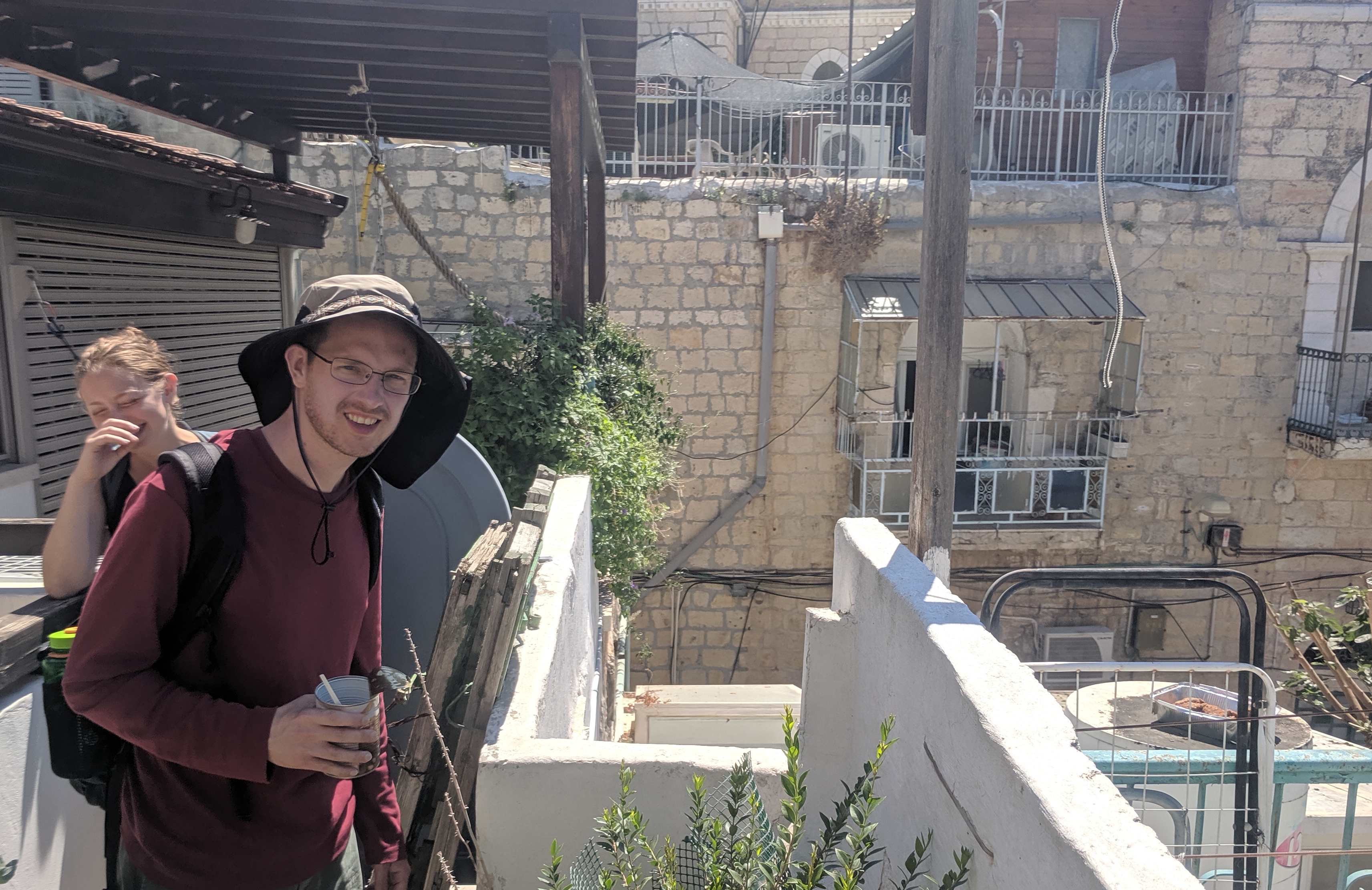
While we were walking around the town, a Mercedes pulled out blasting some kind of EDM with American vocals that went something like “Let me hit… Let me hit… Let me hit it from the back.” Nate and I burst out laughing. In his words, “That went from 0 to 200 real quick.”
We learned that Ein Karem is a popular Christian pilgrimmage spot due to it being the birthplace of St. John the Baptist (right). An Israeli couple who were walking with us tried to strike up a conversation with the priest, but he didn’t know how to speak English; thankfully, Nate was capable of translating from Spanish to English for the couple.
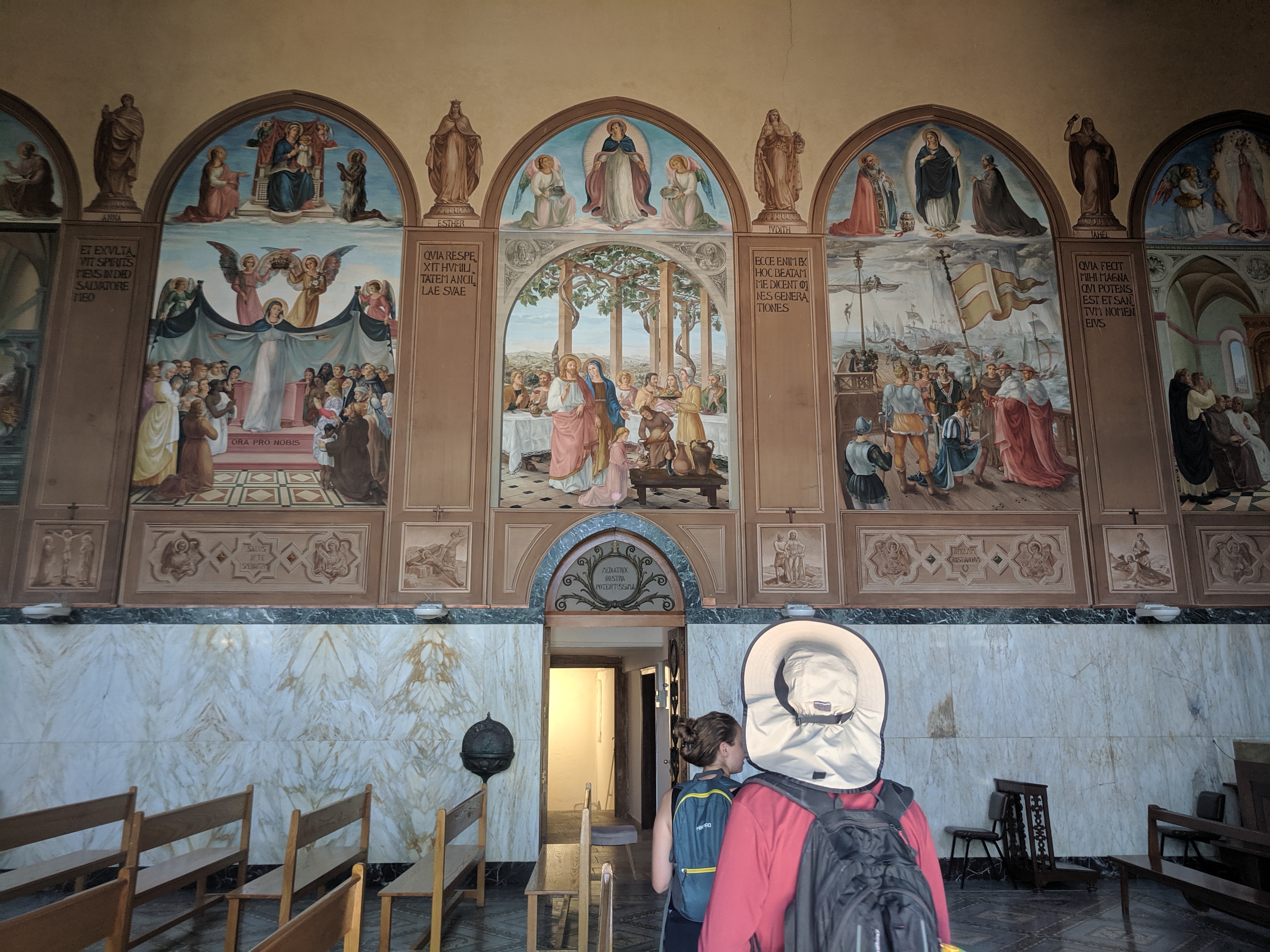
On the way back to the hotel, we debated whether a drunk husband vomiting while professing his love to his wife is romantic, with me on the affirmation and Dani on the negation.
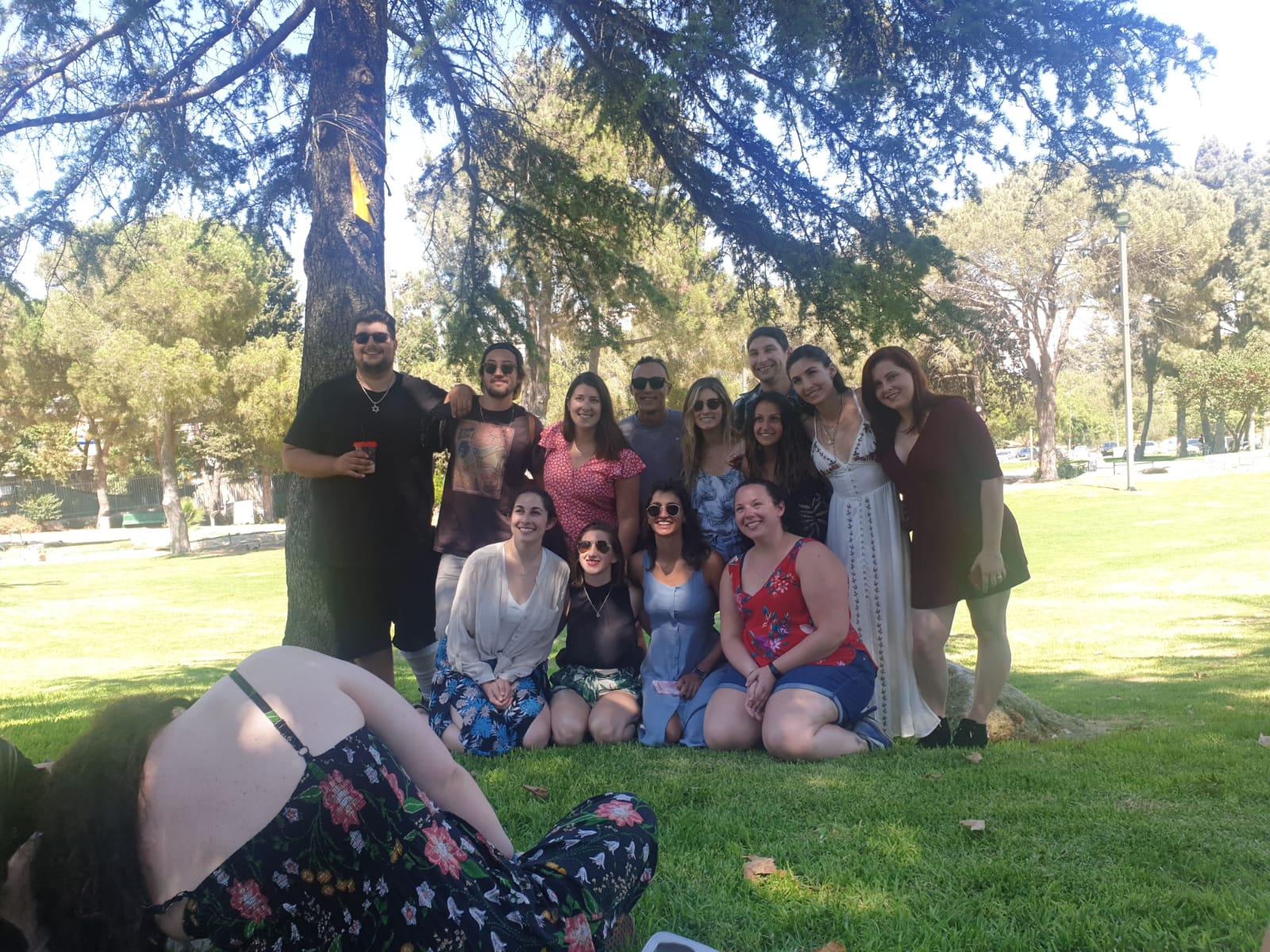 The group spent the rest of the day chilling in a local park. We started with a voluntary
group B’nai Mitzvah. Having never had a Bat Mitzvah, I learned more about the
ceremonial event. 13 years seems a bit early for anyone to make an informed decision
about the obligations they’ll accept, even if a bit of background reading is required
first.
The group spent the rest of the day chilling in a local park. We started with a voluntary
group B’nai Mitzvah. Having never had a Bat Mitzvah, I learned more about the
ceremonial event. 13 years seems a bit early for anyone to make an informed decision
about the obligations they’ll accept, even if a bit of background reading is required
first.
Day 6 - Yad Vashem, Israeli Innovation and Nightlife in Tel Aviv
Yad Vashem is Israel’s Holocaust Memorial. Photos aren’t permitted inside, so I have very few. I’ll share one photo that I snuck because the story touched me. As the picture reads, Roza Robota was interned at Auschwitz where she smuggled explosives to resistance fighters who used her explosives to destroy one of the crematoriums. While her courage was commendable, the reason her memory stayed with me was that when she was captured, she refused to name her co-conspirators, even under torture.
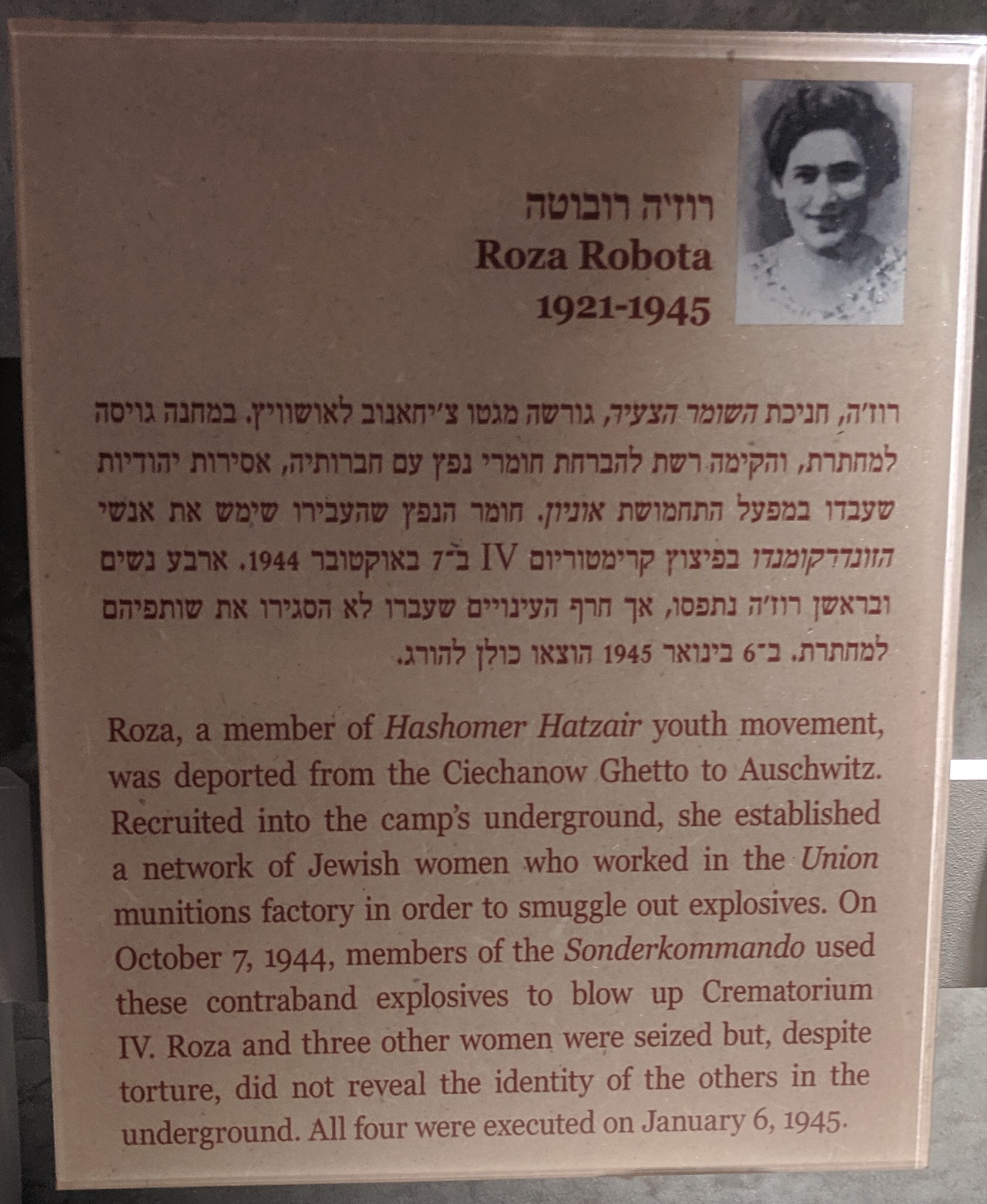 As I stood in the memorial, I imagined that her story was the inspiration for Evey’s
torture scene in V for Vendetta, a scene in which a woman condemned to die in a concentration
camp realizes that her integrity matters more to her than her life. I can’t do the
scene justice in words, but it’s one of the most moving film scenes I’ve seen:
As I stood in the memorial, I imagined that her story was the inspiration for Evey’s
torture scene in V for Vendetta, a scene in which a woman condemned to die in a concentration
camp realizes that her integrity matters more to her than her life. I can’t do the
scene justice in words, but it’s one of the most moving film scenes I’ve seen:
We then departed Jerusalem for Tel Aviv.
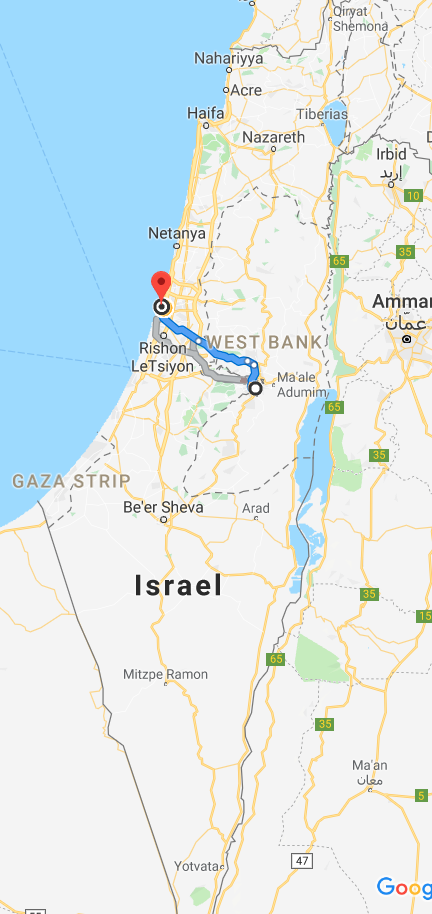
The city had an aesthetic unlike anything I’d previously experienced - tall, shining skyscrapers that looked like Jenga towers juxtaposed with markets offering piles of colorful spices and dried fruit and London-like flats that were all painted white, just next to a beach rivaling the beauty of Santa Monica. It was like a few blocks of NYC had been sprinkled over Tatooine. Our first stop was lunch. We walked along the Mediterranean, marveling at the sparkling sand and bright water. Eventually, we stopped to eat at an Ethiopian cafe. The chai we ordered was tasteless and disappointing, but Adam and I split a plate of delicious, healthy and filling food (right).
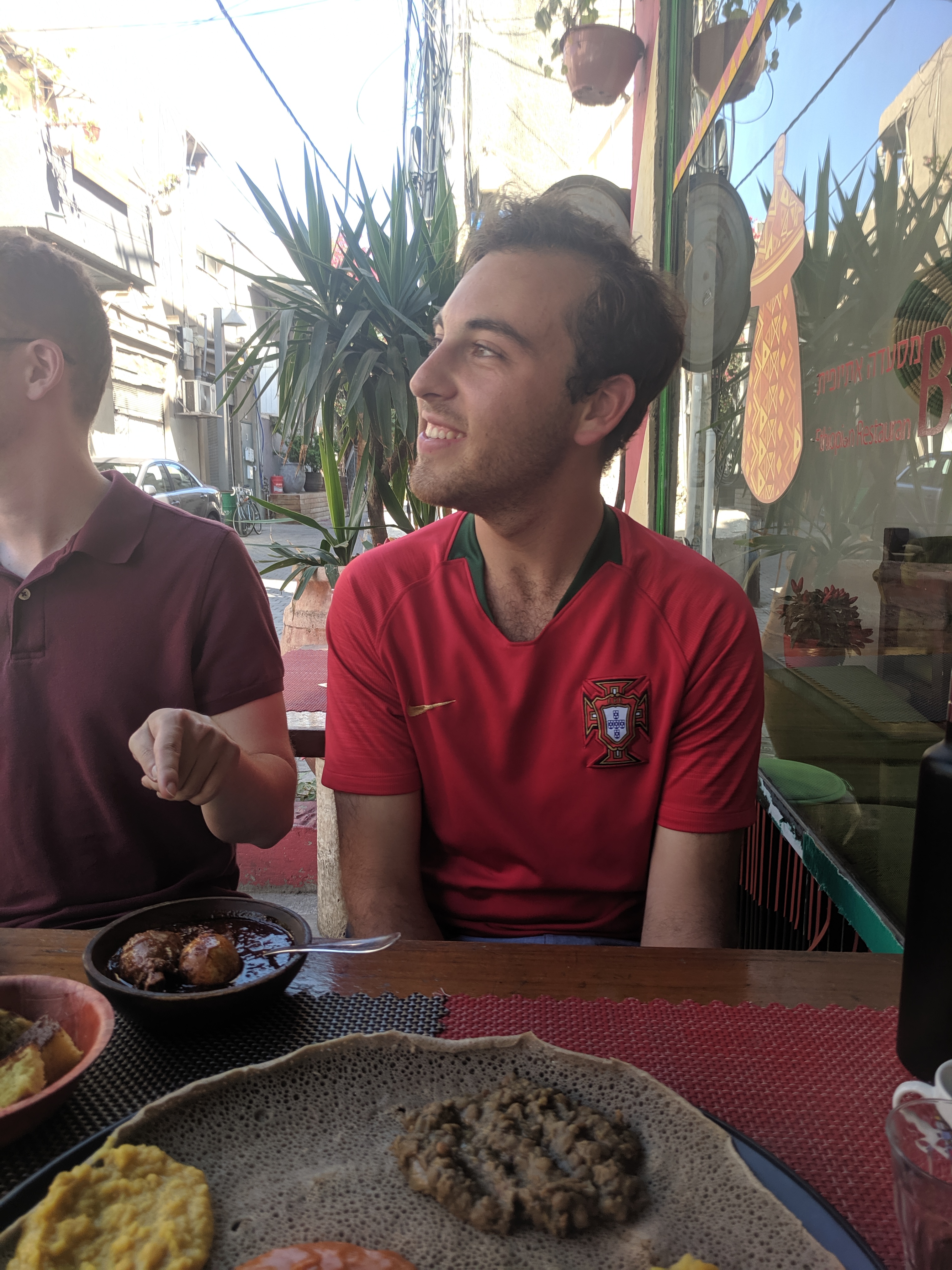
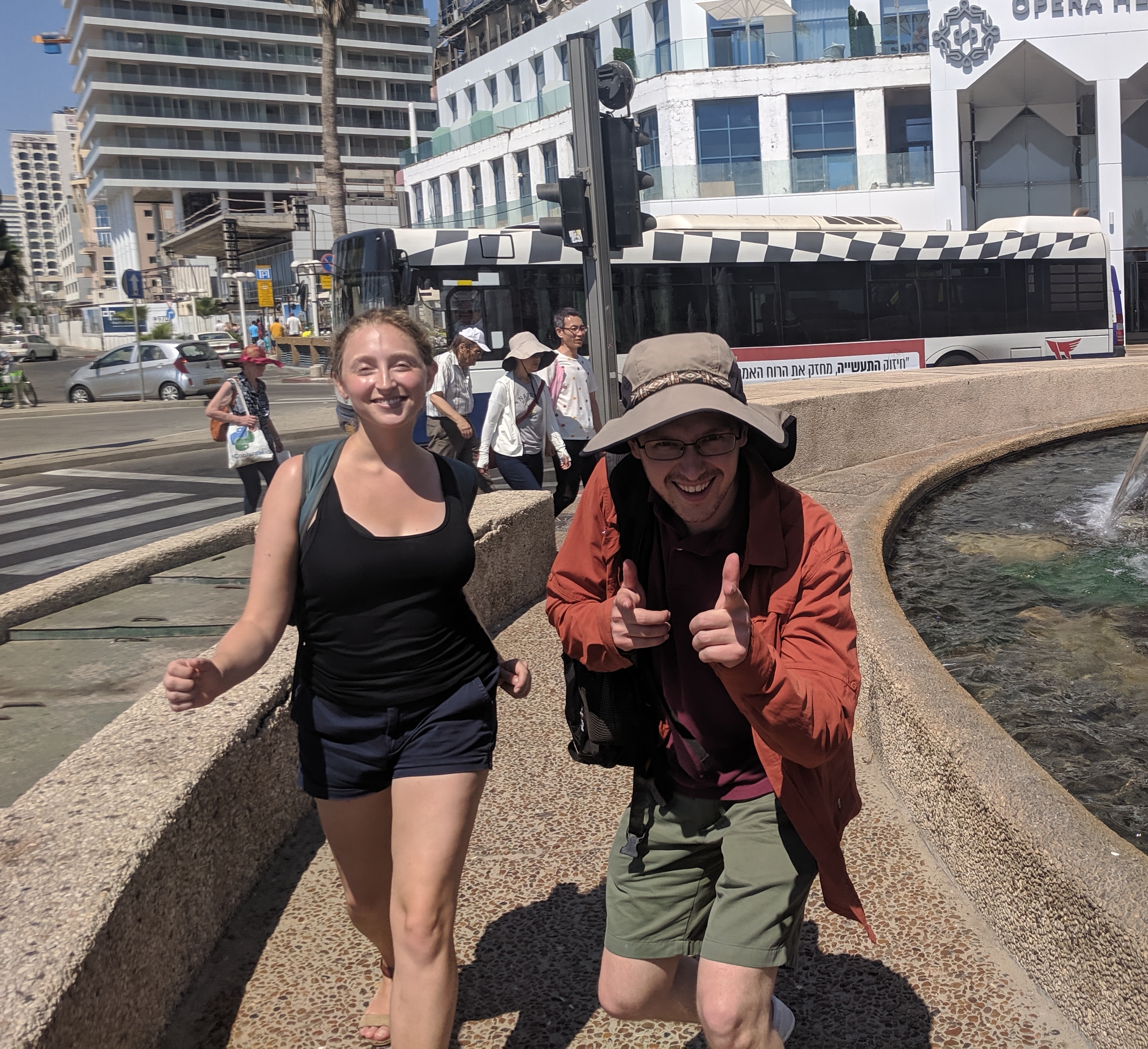
We then went to the Center for Israeli Innovation at the Tel Aviv Stock Exchange. They had an opening bell, so I of course asked to ring it. Turns out the bell is just a way to look like the New York Stock Exchange - it wasn’t actually connected to anything. But the Center was an amazing educational experience interspersed with a touch of comedy. We watched a 10 minute video about the history and current status of entrepreneurship in Israel. To showcase one company that provides audio transcriptions, English subtitles were displayed in addition to the English audio, but subtle problems arose. I burst out laughing when the audio said “Israel needed innovation to survive in this arid wasteland” while the captions read “Israel needed innovation to survive in this Arab wasteland” (emphasis mine). We watched demos of products from two Israeli start-ups: Watergen, which sucks moisture from the ambient air to create water (and can run on solar energy!), and OrCam, a pair of glasses with an embedded system for helping the partially blind see better.

The reason why the Center for Israeli Innovation caught my attention is that I was completely unaware of the magnitude of entrepreneurship in Israel. Israel has the third most companies on the NASDAQ of any country, behind only the US and China. Although I’ve found conflicting sources, some evidence suggests that Israel has more entrepreneurs per capita and more angel/venture capital per capita than any other country. There’s a book on this topic titled Start-Up Nation that delves into this topic (and is now on my reading list), but the short explanation for why Israel excels in this domain is that immigrants are typically risk-takers, that Israel views technological innovation as essential to surviving in a inhospitable climate and hostile geopolitical region, that Israeli culture instill virtues beneficial to entrepreneurship and and mandatory military service provides a process for giving youth real-world experience and a network of connections to later rely on. This was my first hint that Israel as a country is deliberate and considered in what they do, moreso than say, the United States.
That night, we were given the freedom to explore Tel Aviv. Dani, Nate and I decided to walk as far south along the shoreline as time would permit. As we walked along the shore, our conversations swayed in the breeze, touching all manner of topics. One topic we discussed was marriage advice we had received from our parents. Dani said her mother once told her, “Marry someone who makes you laugh because life is hard.”
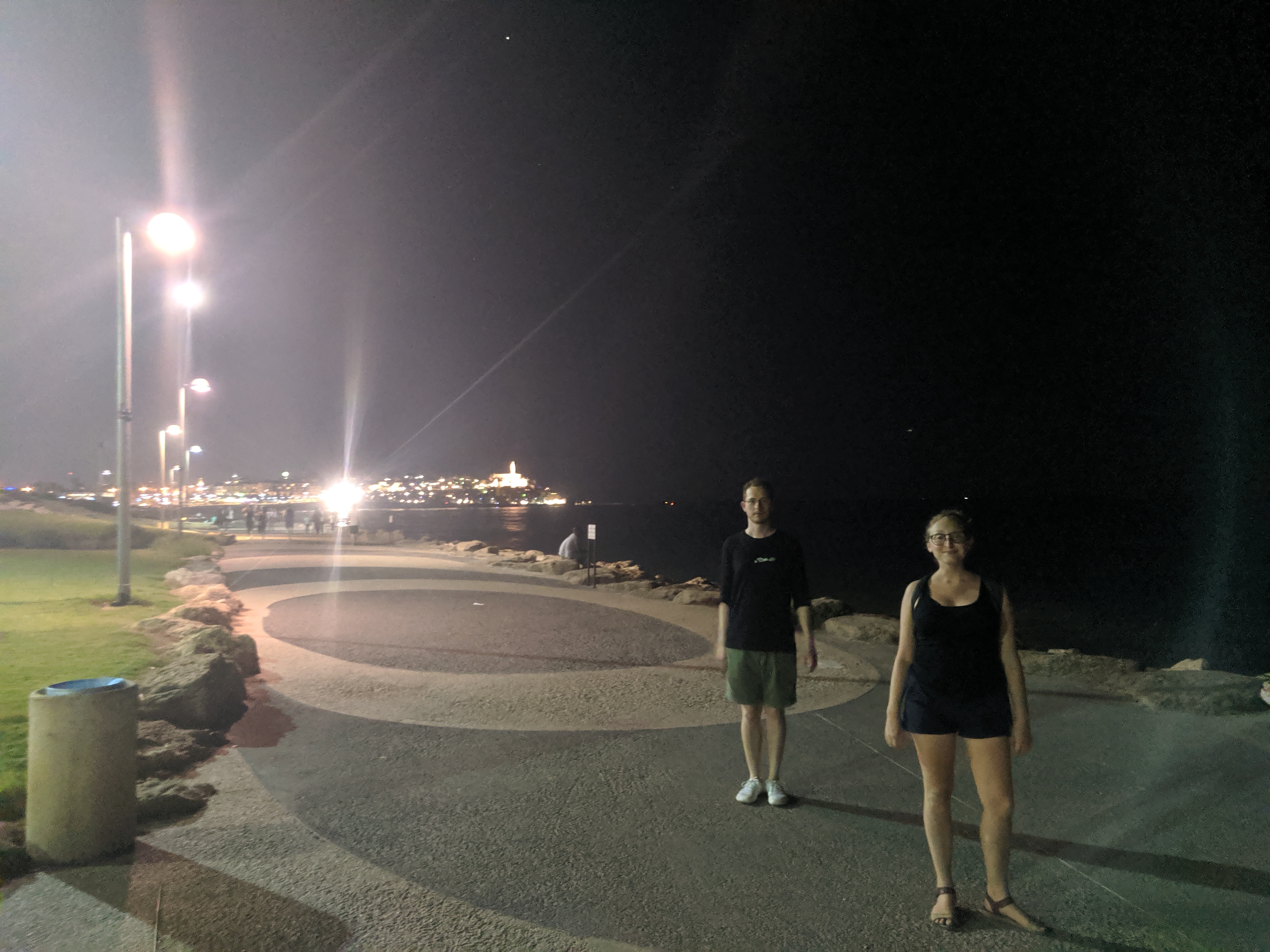
Day 7 - Gentrification in Tel Aviv and Bedouins in the Negev
We started the day with an opportunity to explore Tel Aviv in small groups. My group explored a new shopping center a multi-story shopping mall. We also walked by the Camp Rabin military base and its Marganit Tower. The Israeli in our group told us that Tel Aviv has recently been experiencing significant gentrification that gives rise to new malls.
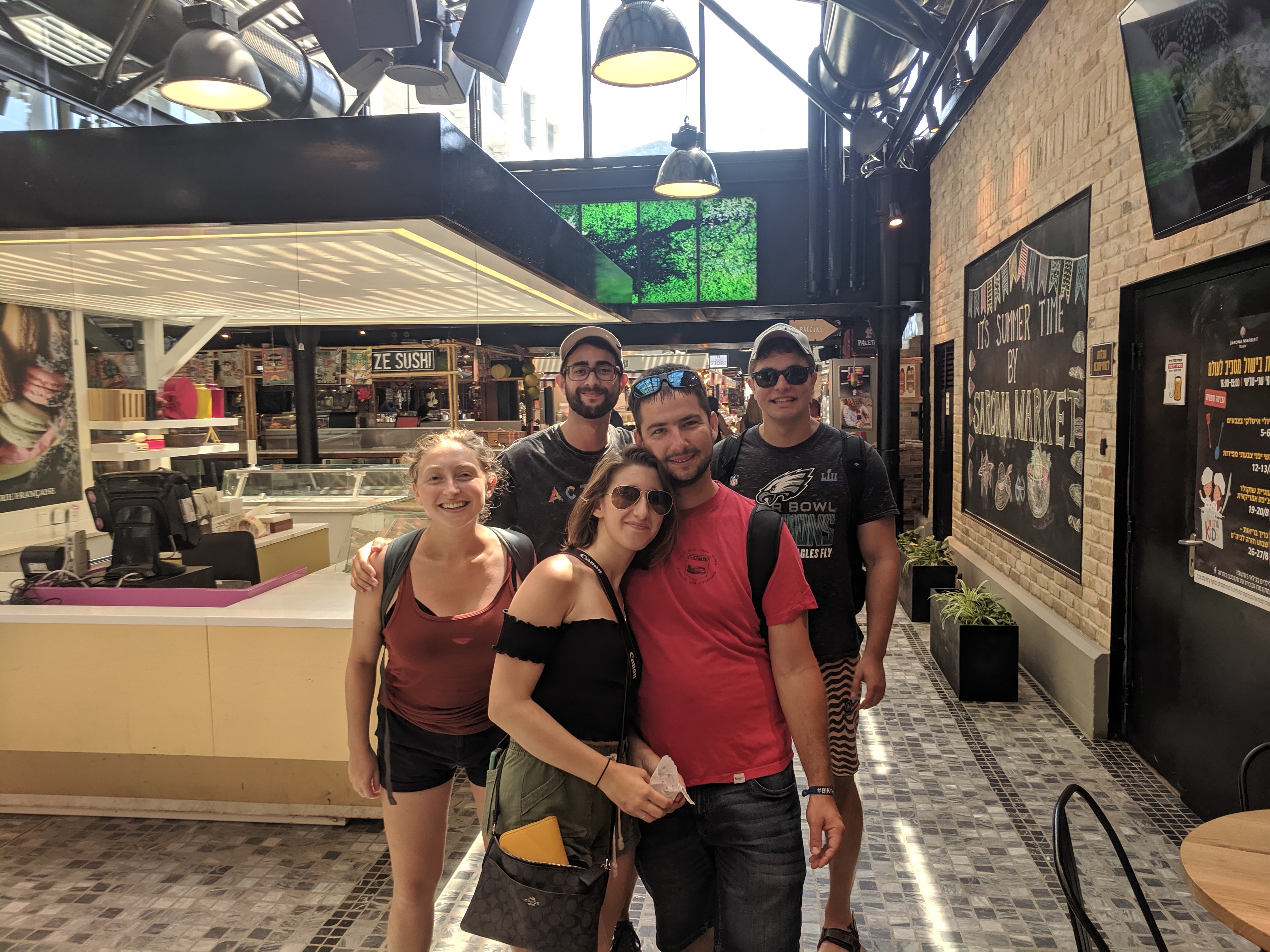
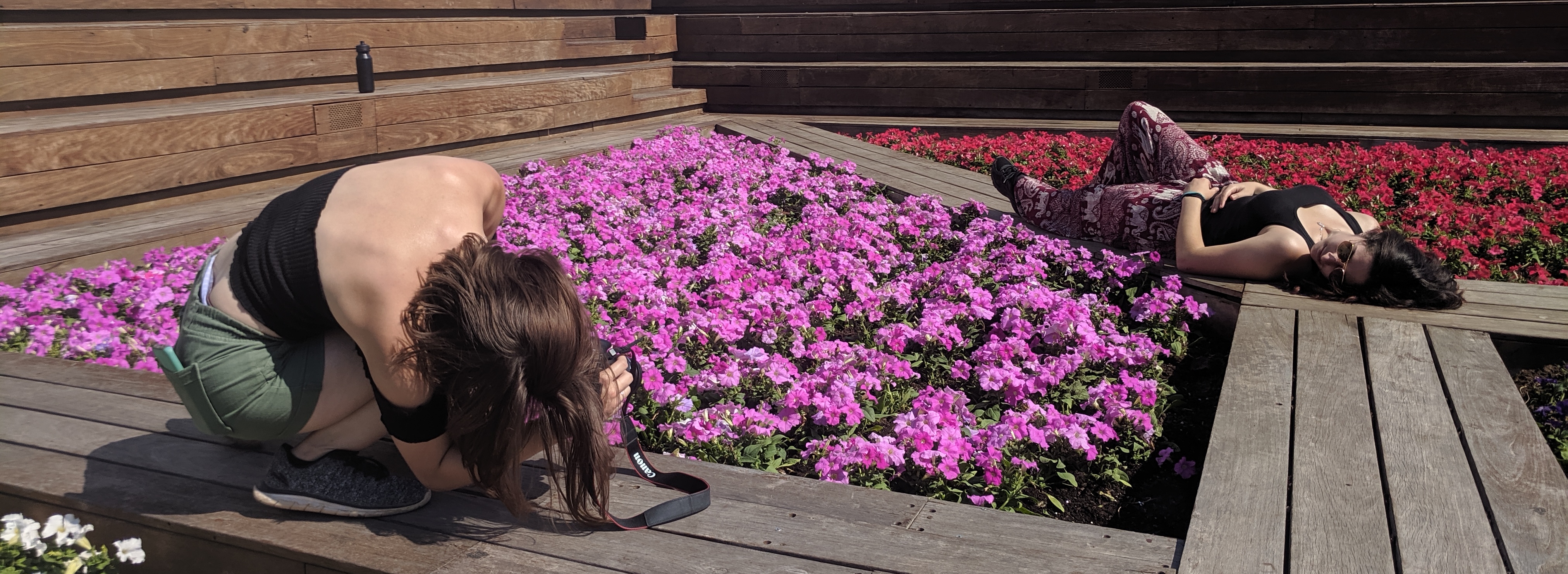
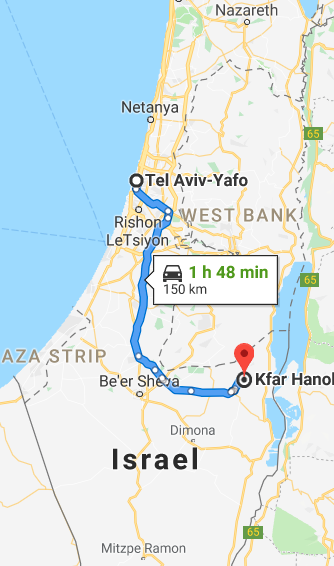 We then traveled out to the Negev (Kfar Hnokdim, specifically) to stay the night at
a Bedouin campement. Bedouins are nomadic Arabs who live across countries in the Middle
East. They famously discovered the
Dead Sea Scrolls. Within Israel, the Bedouins are a difficult political problem.
Previously, Israel worked to build towns and cities for the Bedouins, but struggled to
resolve their infighting and meet their requests. In 2014, Israel’s head of Bedouin
resettlement arrangements stated that the government was looking into how to lower their
birthrate.
We then traveled out to the Negev (Kfar Hnokdim, specifically) to stay the night at
a Bedouin campement. Bedouins are nomadic Arabs who live across countries in the Middle
East. They famously discovered the
Dead Sea Scrolls. Within Israel, the Bedouins are a difficult political problem.
Previously, Israel worked to build towns and cities for the Bedouins, but struggled to
resolve their infighting and meet their requests. In 2014, Israel’s head of Bedouin
resettlement arrangements stated that the government was looking into how to lower their
birthrate.
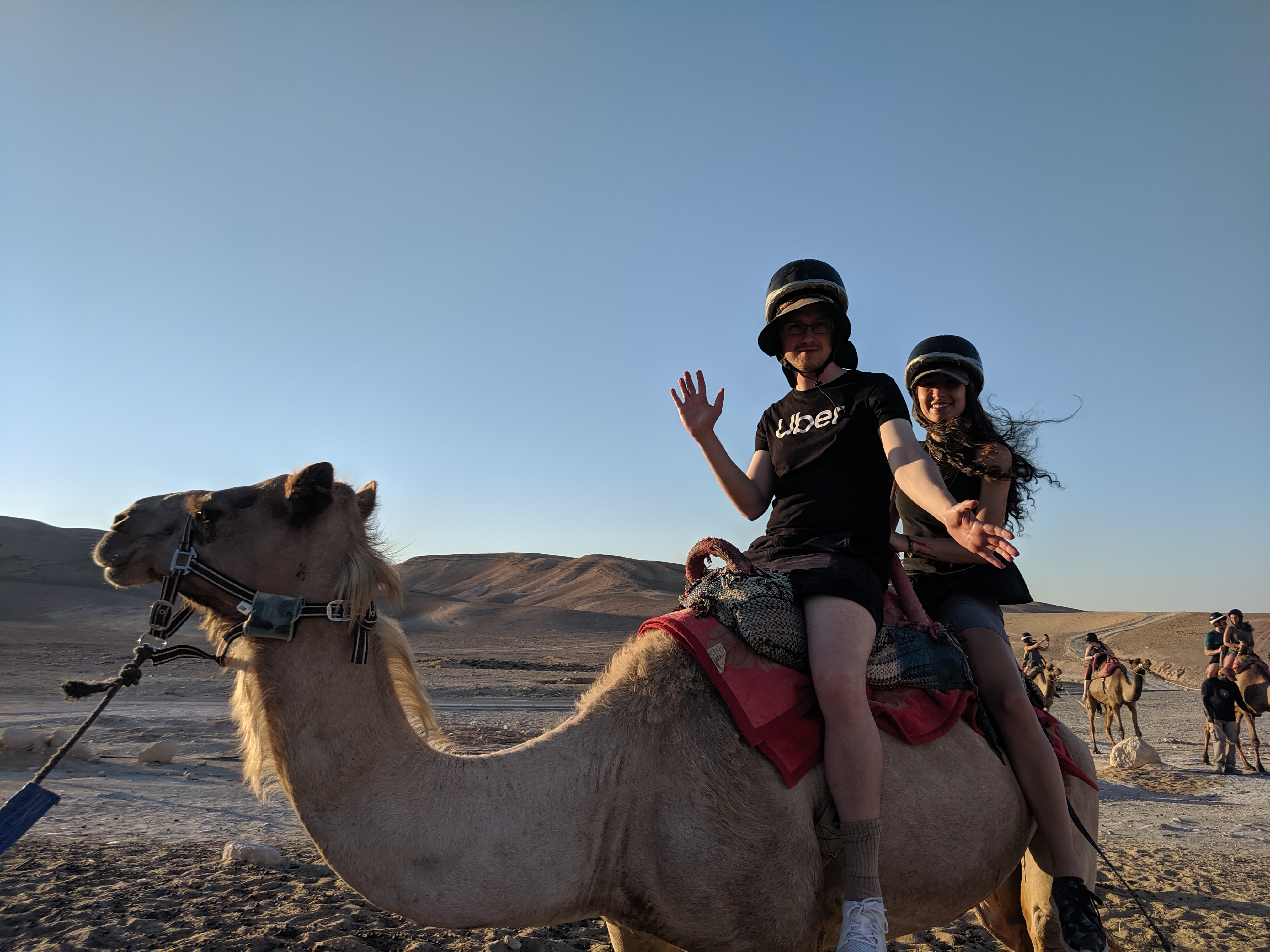
Small side story: after I returned from Israel, a friend of mine told me a funny story about a Bedouin he met while traveling through parts of Morocco. The Bedouin guide asked my friend if my friend knew why Arab men have so much more “vigor” than Western/European/American men. He then launched into his view on the subject, exclaiming, “[Western] men, they see hot women all the time. They see women unclothed, naked. But we don’t! Our women are covered, so you have only your imagination. But then, when the clothes come off, we are passionate and strong.” He then launched into telling my friend how there’s a growing industry of sexual tourism in North Africa in which wealthy European women seek fit young Arab men.
Our final group activity before bed was a stargazing night hike. Unfortunately, the moon was far too bright to see anything. Our guide used a nightlight to reveal that the landscape was dotted with deathstalkers, a species of scorpion that excels at camouflage and delivering a small dose of neurotoxins capable of killing humans. There was something mystical about being out in the desert, surrounded by silence, that enchanted Nate and I. We spoke with the camp’s security guards and asked for permission to run to the top of the nearest ridge (maybe 4 miles away). They gave their blessing, so off we went. The run was one of my favorite parts of the trip. I can’t describe why the run was so enrapturing. There’s just something hypnotic about feeling the warm-but-simultaneously-relaxing desert night air with the stars twinkling above, running over ground illuminated by the moon as clear as day. As we nearest the crest of the ridge, we heard an Arabic song drifting over the hills, shared with the night by a local. We debated approaching their small camp, but decided to defer towards safety. In the photo below, the glow in the center is our Bedouin camp, and the lights to its left and right are other towns on the horizon.

Oh yes - at the Bedouin camp, our entire group (~50 people) slept in the same tent. Some people joked about looking forward to a poor night’s sleep, I fell asleep almost instantly in the tent and slept without interruption. Maybe I was just exhausted from the run.
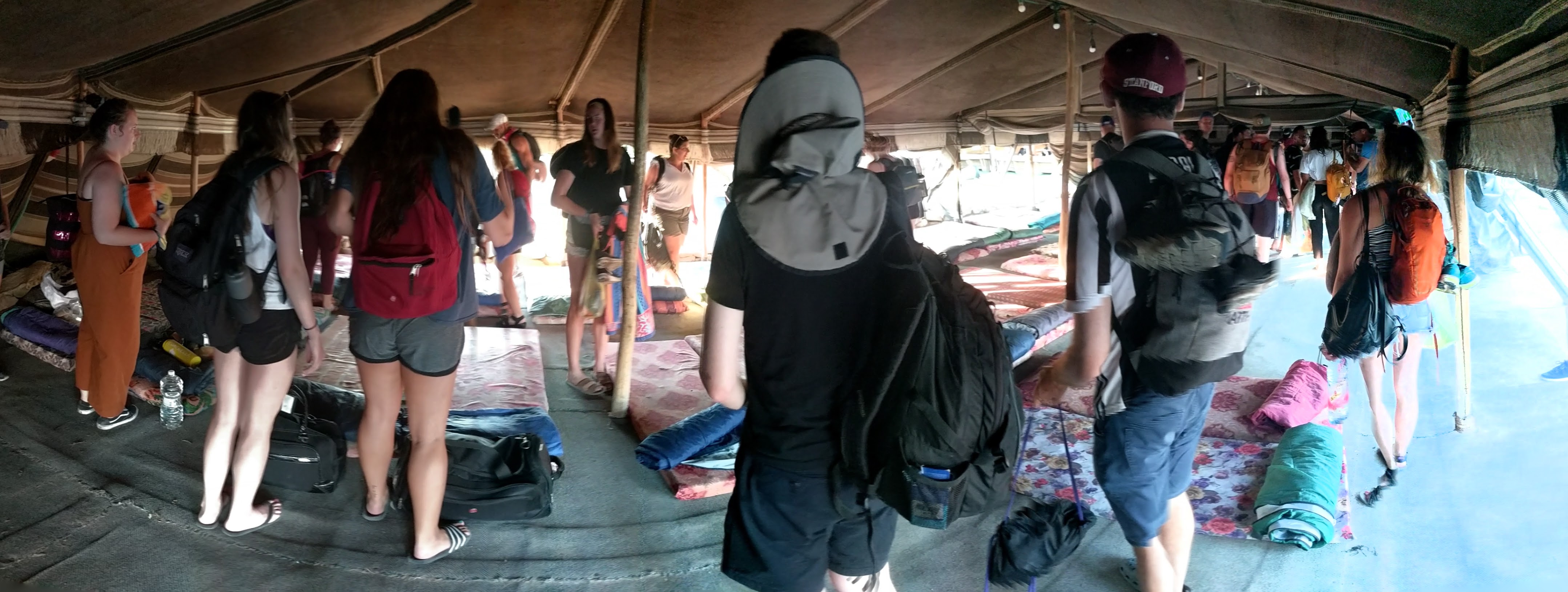
Day 8 - Masada, the Dead Sea and Ben-Gurion’s Tomb
Day 8 started early (too early) with an intense hike to watch the sun rise over the desert from the ruins of Masada, an ancient fortress at the top of an elevated buttress. Masada was ordered constructed between 37 - 31 BCE at the command of Herod the Great, the same King responsible for constructing the Second Temple in Jerusalem and for ordering the slaughter of all male children under 2 (although historians hold this second charge to be fictional). In 70 CE, Jewish rebels declared independence from the Roman Empire and fled to Masada in the desert. A Roman regional governor decided to make an example out of these miscreants and sent a legion to lay siege to Masada.

Typically siege methods were ineffective against Masada given its positioning, so the Roman legion literally moved a small mountain to create a new entrance to the elevated plateau and then used a system of pulleys to pull a massive siege tower up the hill. Allegedly, the Romans, after hoisting their siege weapon, waited till the morning to attack; that night, to avoid being taken into slavery, the Jews at the top of the hill struck a pact that every man would kill his wife and his children, that each man would be killed by another man until one remained, and that man would commit suicide. Our guide told us that he’s considered having to make such a decision. He said that the worst choice would be choosing whether to kill his wife or his children first; at that point, he said, the rest would be easy.
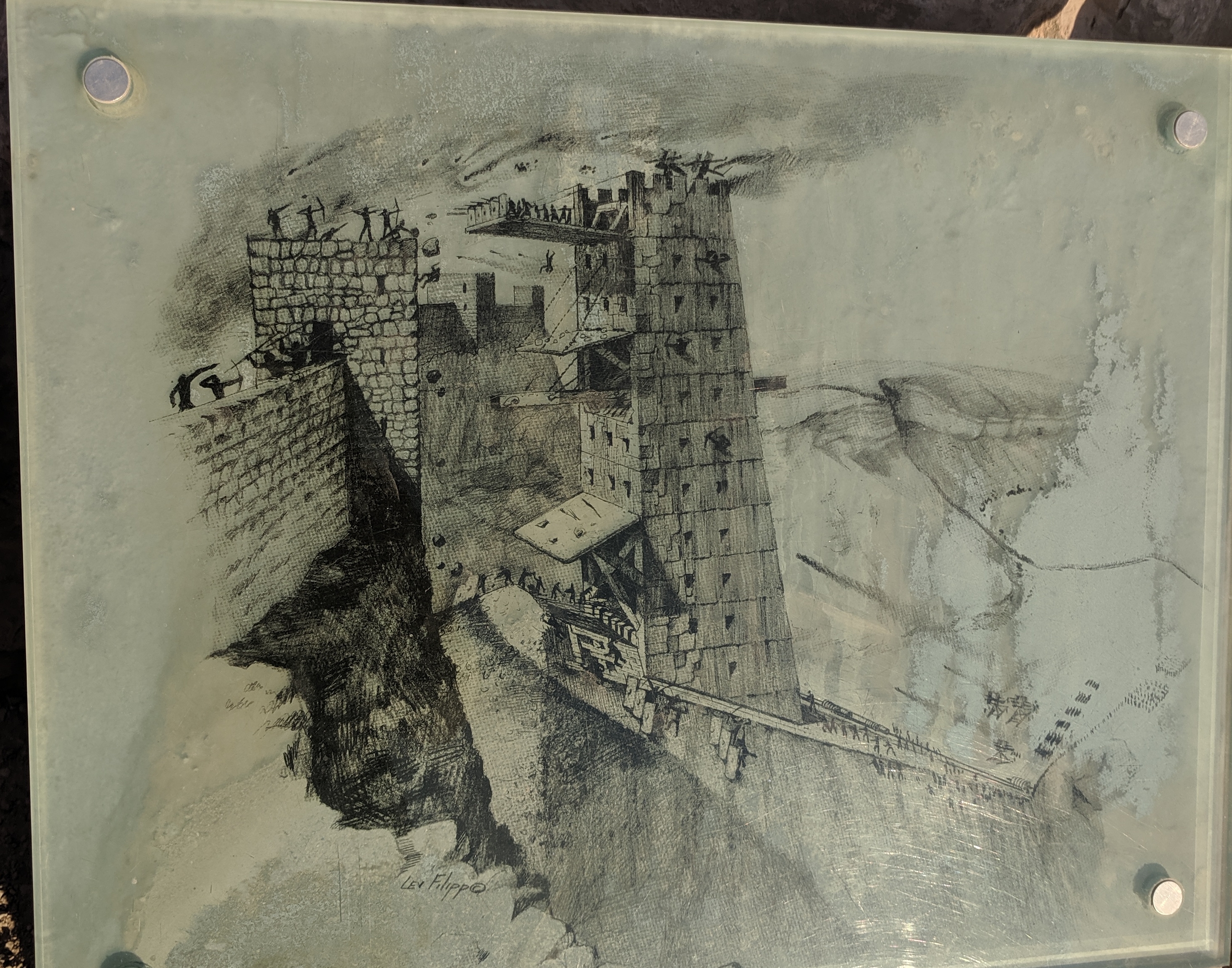
At the time, I mentioned to Nate that I had strong doubts about the story we were told. What bothered me wasn’t the suicide pact, but the alleged lack of bodies discovered during archaeological excavation; 960 people allegedly died, but only 3 corpses were discovered. It’s hard to imagine a Roman legion being ordered to carry so many bodies back across the desert. One Israeli in our group told us that the sole source of the story was a Jewish to Roman/Catholic convert, which further raised our suspicions. The Wikipedia article also mentions other inconsistencies between the story and archaeological discoveries.
Fun fact: the Jewish rebels defending Masada were called the Sicarii and are the source of the word “sicario,” as mentioned at the start of Denis Villeneuve’s film of the same name.
We then bused to the Dead Sea. From a distance, it looks like a gorgeous white sand beach, but that’s deceptive! There is no sand - the whiteness is hardened salt crystal. Several people (in our group and others) made the mistake of unknowingly lacerating their feet on the salt before walking into the water. One crazy guy on our trip dove into the Sea, despite warnings by our guide not to do so. We learned that the Dead Sea was previously fed by the Sea of Gallilee, but that Israel has stopped that flow to preserve drinkable water and that the Dead Sea has started falling by about a meter and a half each year. Our guide told us that the words “salary” and “soldier” both stem etymologically from “salt” since Roman soldiers were historically paid in salt. I looked this up and sadly it appears to be false.
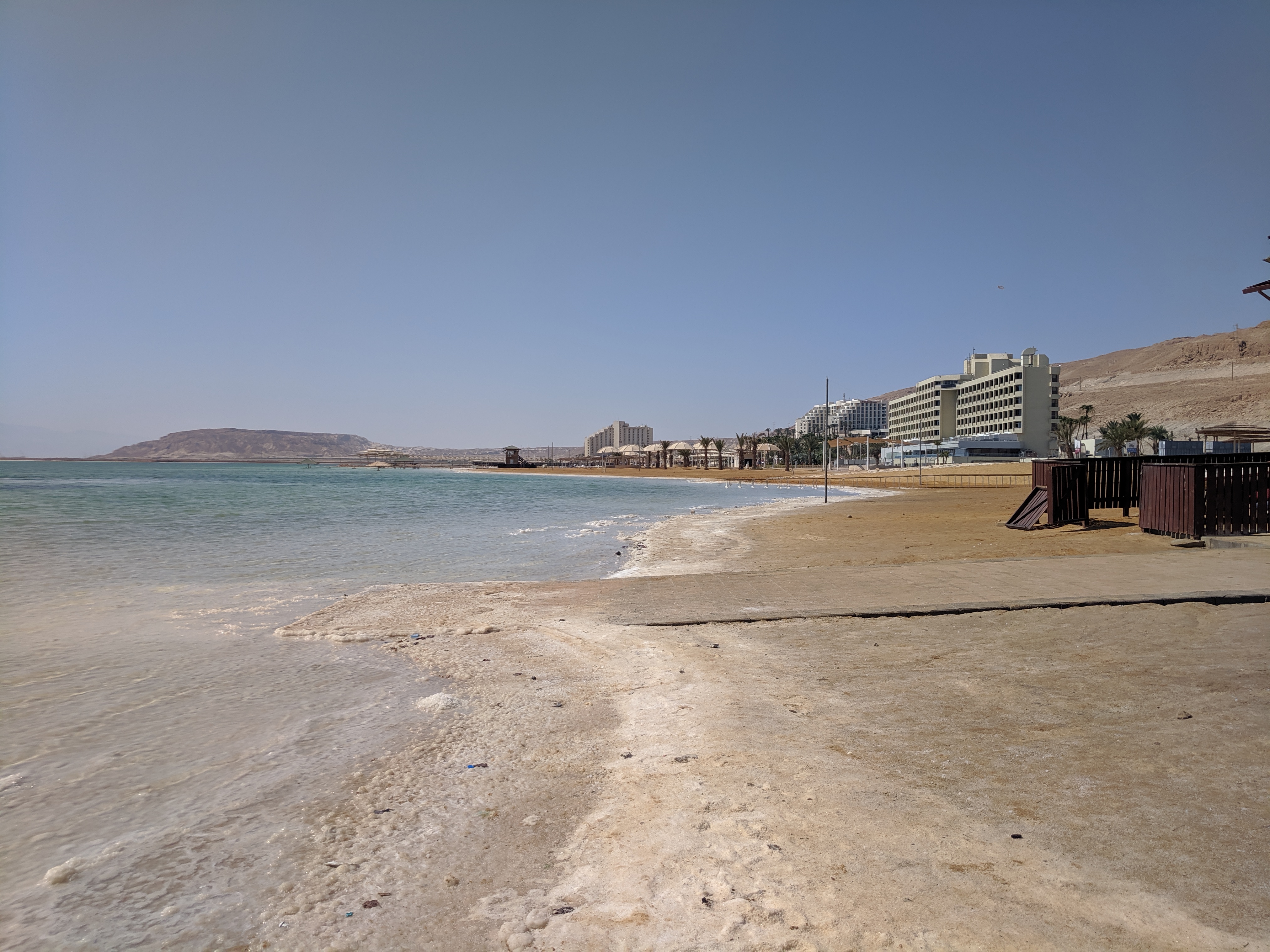
We visited the tomb of David Ben-Gurion, Israel’s first prime minister, in Midreshet Ben-Gurion where we learned about his background and his vision for Israel.
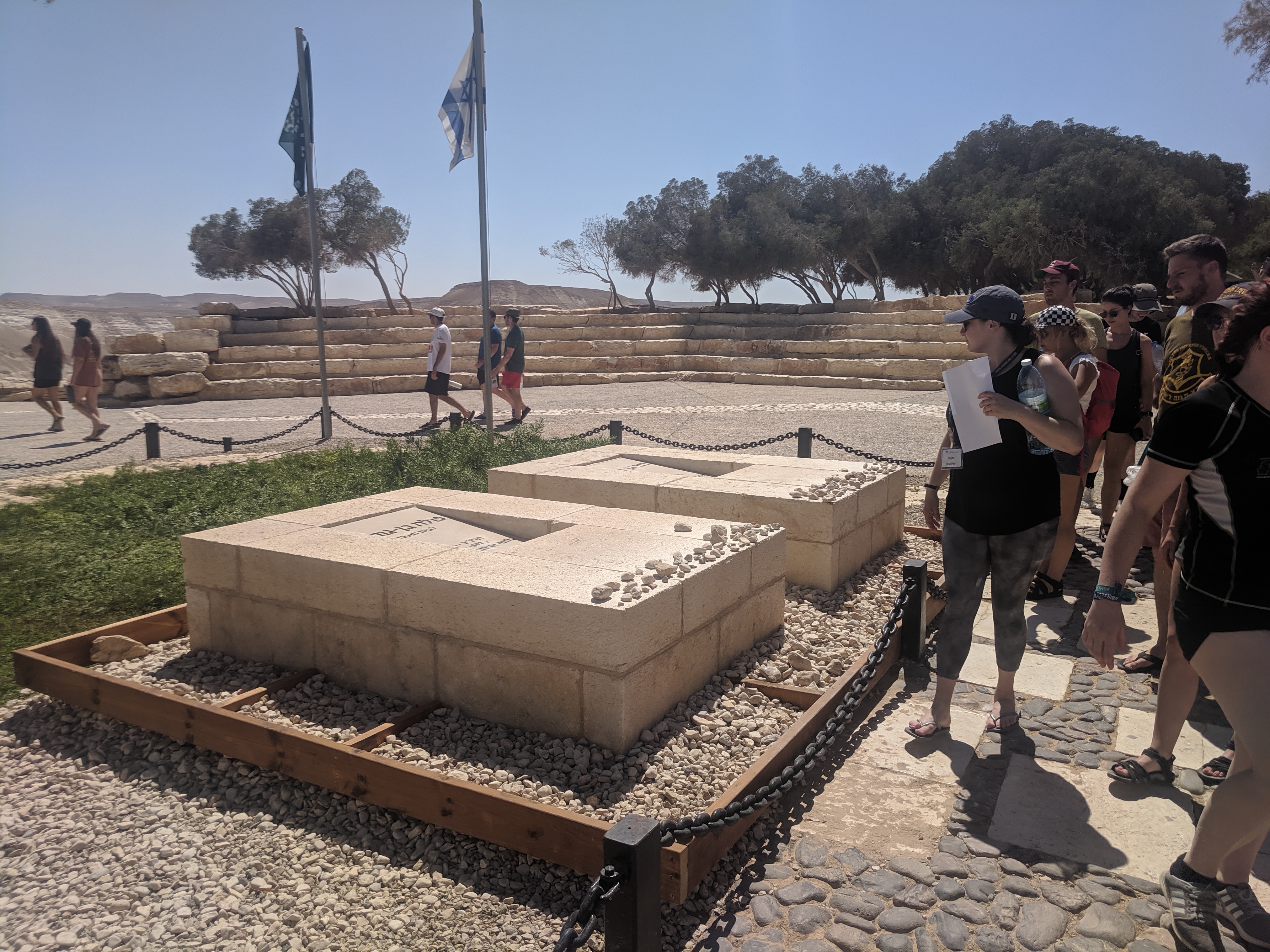
One amusing story is that when he arrived in Israel, he tried working at a kibbutz but was a terrible worker. He left to become a journalist, then a minister, and finally the first prime minister. After he retired, he applied to join another kibbutz, Sde Boker, in the Negev. Rather than being accepted with open arms, half the community was opposed to him joining because kibbutzim are work communities and many didn’t see the utility in permitting an elderly man to join. The community voted, and with a difference of just a single vote, Ben-Gurion was permitted to join. Another story that I sadly can’t find any evidence for (but maybe I just need help searching in Hebrew) is that Ben-Gurion was apparently famous for his ability to negotiate. He said of himself, “I compromise and I compromise until I get what I want.”
Our guide mentioned that Ben-Gurion had a vision of transforming the Negev from a desert into a lush, plentiful world. Glancing around at the small shrubs, it was hard not to make a sarcastic mark. But when I looked more into why Ben-Gurion felt this way, I learned that he saw cultivating the desert as not just a practical necessity for Israel, but a virtuous exercise in self-mastery. I copied excerpts from his memoirs that spoke to me (emphasis mine):
One day, when I had occasion to drive to Eilat on official business as Prime Minister, I told the driver to leave the main road onto a dirt path in the desert. I wanted to break away from my busy schedule and to take a few moments to plunge myself into the vast stretches of the desert, to renew myself by experiencing the awesome effect of these open spaces, which will never be diminished in my eyes, with their double message of the insignificance of man in an infinite universe and about the hope that animates him. We drove along the path for some time and suddenly we saw a gathering of people and a few wooden shacks before us. We stopped and I descended the embankment to inquire about the young people there: “What are you doing here?” They said that in their own manner, they were leading a battle for the independence of Israel by reclaiming the desert [...] This is how I finally took a leave of absence from the government to settle in Sde Boker in 1953. My first days at the kibbutz were especially difficult. My physical condition left much to be desired. But I was determined to dissuade my comrades from according me special treatment. For this, I had to keep pace with the best of them. During those first weeks, I was exhausted and how I struggled with myself to hide it! The kibbutz practiced the rotation of duties. A list of duties with the names of the persons scheduled to do them was pinned on the notice board. The first time that I looked at it, I discovered that they had assigned Mr. Ben Gurion to sheep shearing while the first names of everyone else appeared on the list. I immediately went to see those responsible to declare that it was not Mr. Ben Gurion who had joined the kibbutz but rather David, simply David. [...] My attitude, moreover, prompted the foreman to test me by assigning the heaviest and most difficult, irksome tasks. I concealed from him that I had guessed his intentions. [...] To be at peace with oneself and to struggle to accomplish a task related to nature in which one believes, what more can you wish for in life?! Within a few weeks, I became so tough that I felt capable of enduring everything. [...] Each man must look within himself for his reason for living. For example, now that I am old, I am increasingly confronted with the prospect of death. Some time ago, a young man asked me if I was afraid to die. I resorted to the Talmud method that consists of replying to a question with another question: “What does it matter if I am afraid or not? I know that I must one day die, why then be afraid?” [...] We need Jews, natives of the United States, Rhodesia, Iraq, Russia or elsewhere. We wish to see them come to us to live freely and fully both as men and as Jews as nowhere else. They will have to work hard in order to create a new civilization, something completely new. We want them to settle in the desert to make something different out of it than what we have known up to now on earth that is better adapted to the environment and that will be a source of inspiration to all humanity. The desert provides us with the best opportunity to begin again. This is a vital element of our renaissance in Israel. For it is in mastering nature that man learns to control himself. It is in this sense, more practical than mystic, that I define our Redemption on this land [...] When I looked out my window today and saw a tree standing before me, the sight awoke in me a greater sense of beauty and personal satisfaction than all the forests that I have crossed in Switzerland and Scandinavia. For we planted each tree in this place and watered them with the water we provided at the cost of numerous efforts. Why does a mother love her children so? Because they are her creation. Why does the Jew feel an affinity with Israel? Because everything here must still be accomplished. It depends only on him to participate in this privileged act of creation.
David Ben-Gurion met his wife, a Russian Jew, in New York City. In an interview late in his life (and probably elsewhere), David describes his wife Paula as principled and headstrong, writing ““She was a remarkable woman. She was not a Zionist, she had very little Jewish feeling, she was an American, she was an anarchist. At that time, all the progressive youth were anarchists. And her hero was an anarchist woman, (Emma) Goldman. This was the greatest (person) she knew. She had no interest in Israel, she didn’t know what for. ‘America is better, why do we need the land of Israel?’ But when we decided to marry each other I told her, ‘you will have to go to Israel,’ and I told her what Israel is, then. And she agreed.” One wonders how he explained what Israel is.
Day 9 - Ein Avdat National Park and Mount Herzl
On our second-to-last day of the trip, we started by hiking Ein Advat, an ancient canyon in the desert near kibbutz Sde Boker and the tomb of the Ben-Gurions. Our guide told us that the area was ancient, but I didn’t realize how ancient - evidence of tools used by humans in the area date back 80,000-90,000 years. A small river ran through the canyon, slowly continuing to whittle the hard stone away. We climbed the wall of the canyon, stepping inside ancient caves that were formerly inhabited. In the center back of the image, you can make out a small green line - that’s the memorial built for David Ben-Gurion.
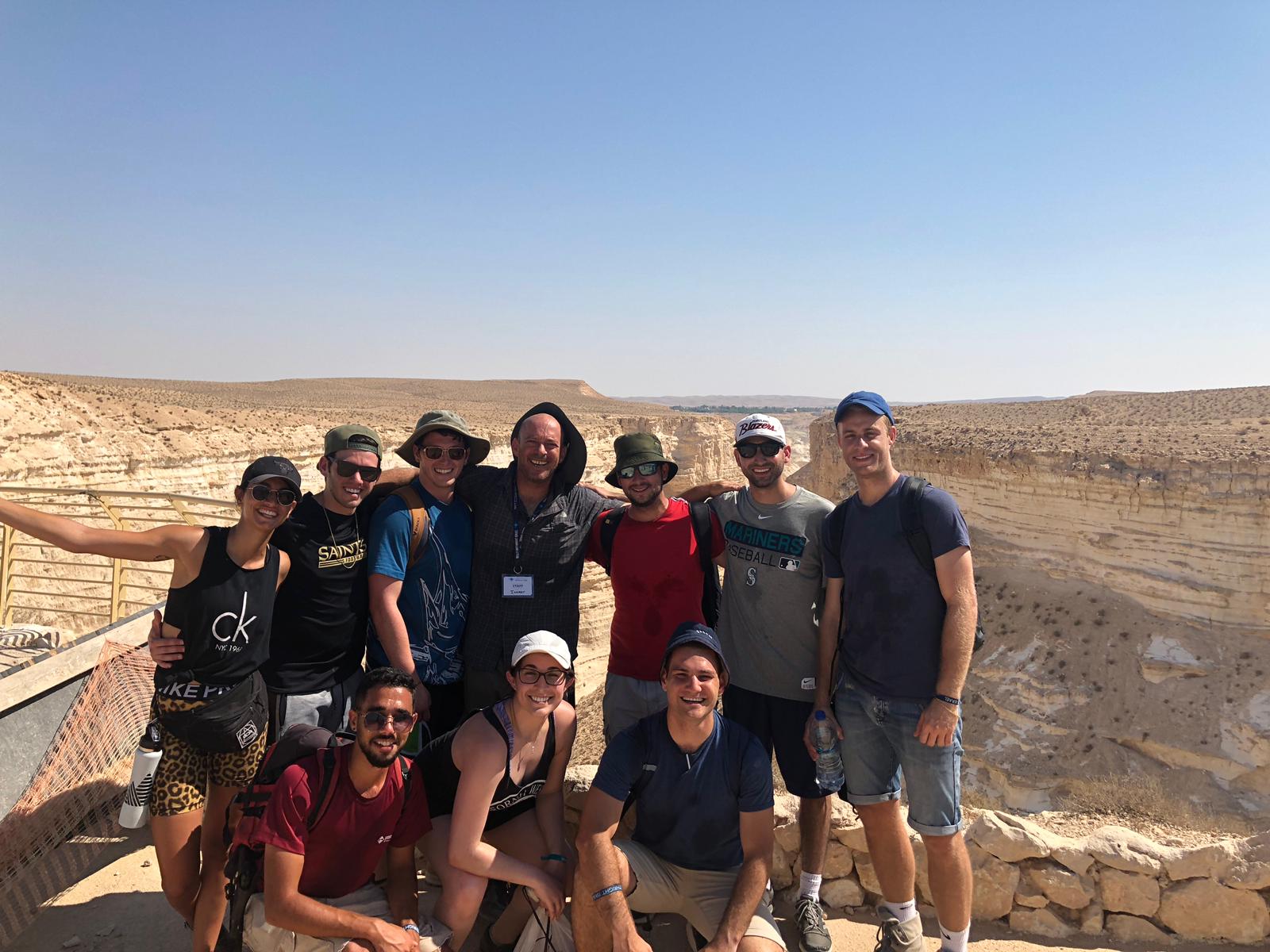
Our final stop was at Mount Herzl, a graveyard built to memorialize those who died defending Israel. The name comes from Theodor Herzl, the founder of modern political Zionism. Mount Herzl is located near Yad Vashem, intentionally so.
Some of the Israelis traveling with us wore their dress blues and shared stories, either of their own experiences or of noteworthy stories. I remember four stories. One concerned PTSD and the difficulty soldiers face when returning to civilian life, finding themselves unable to adapt or even discuss their feelings with others because PTSD is such a difficult concept to communicate. Another concerned Israel’s policy that whenever Israel seeks to send a family’s second son to a combat zone, the government must ask the mother of the boys for her blessing. The third was the story of Yonatan Netanyahu, the brother of current prime minister Benjamin Netanyahu who died rescuing hostages in Uganda in 1976; I was most impressed by Israel’s commitment to the idea that all must serve, regardless of wealth or education. The fourth was the personal story of one of the Israelis traveling with us, who gave up his chance at playing football (soccer) professionally to serve in the IDF. He told us that his father had served in the IDF in the 1980s, in a unit that had tortured civilians, and that when his father was mandated to return to active duty, his father refused on ethical grounds and was jailed until his former military commander spoke in his defense.
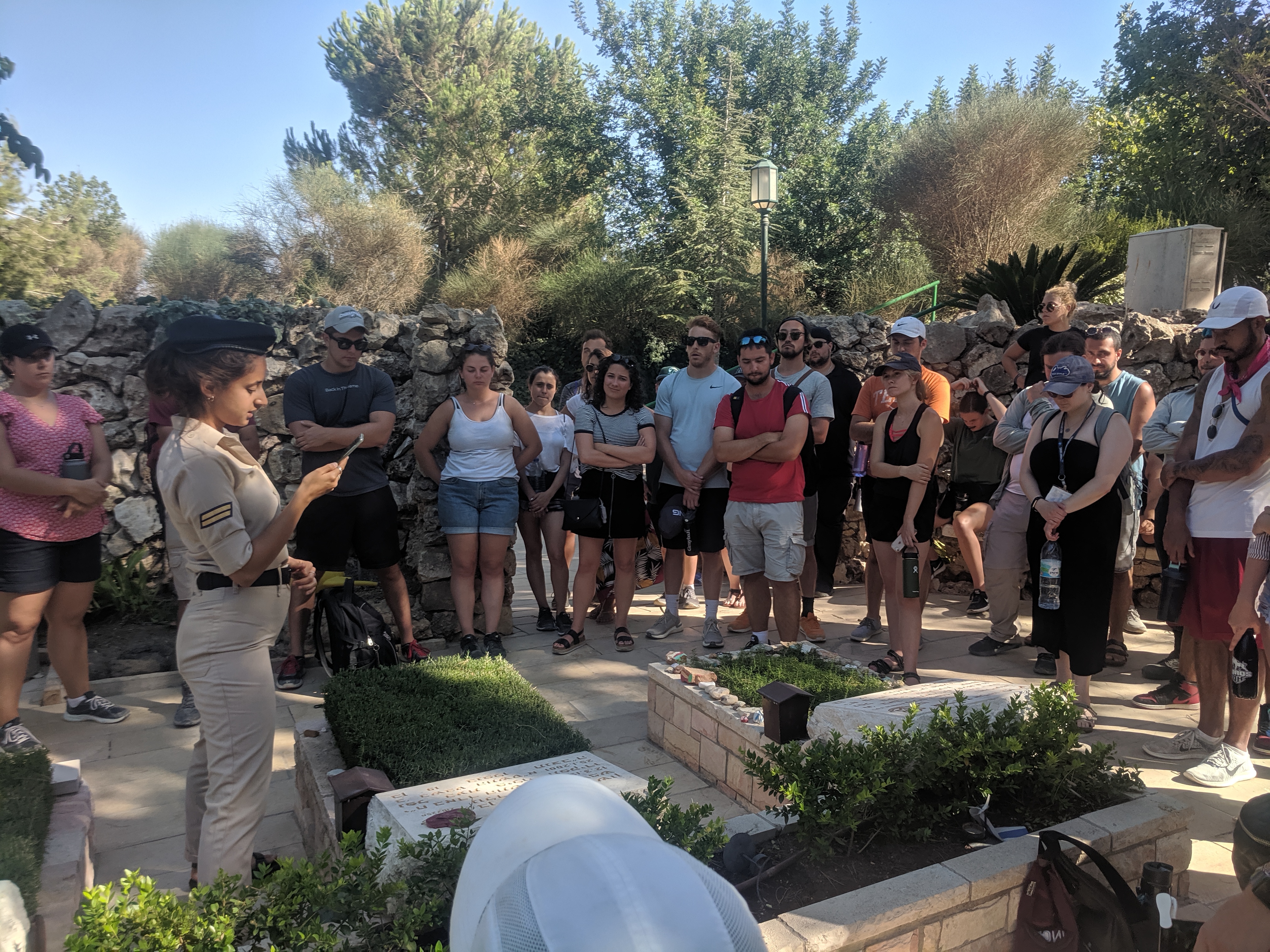
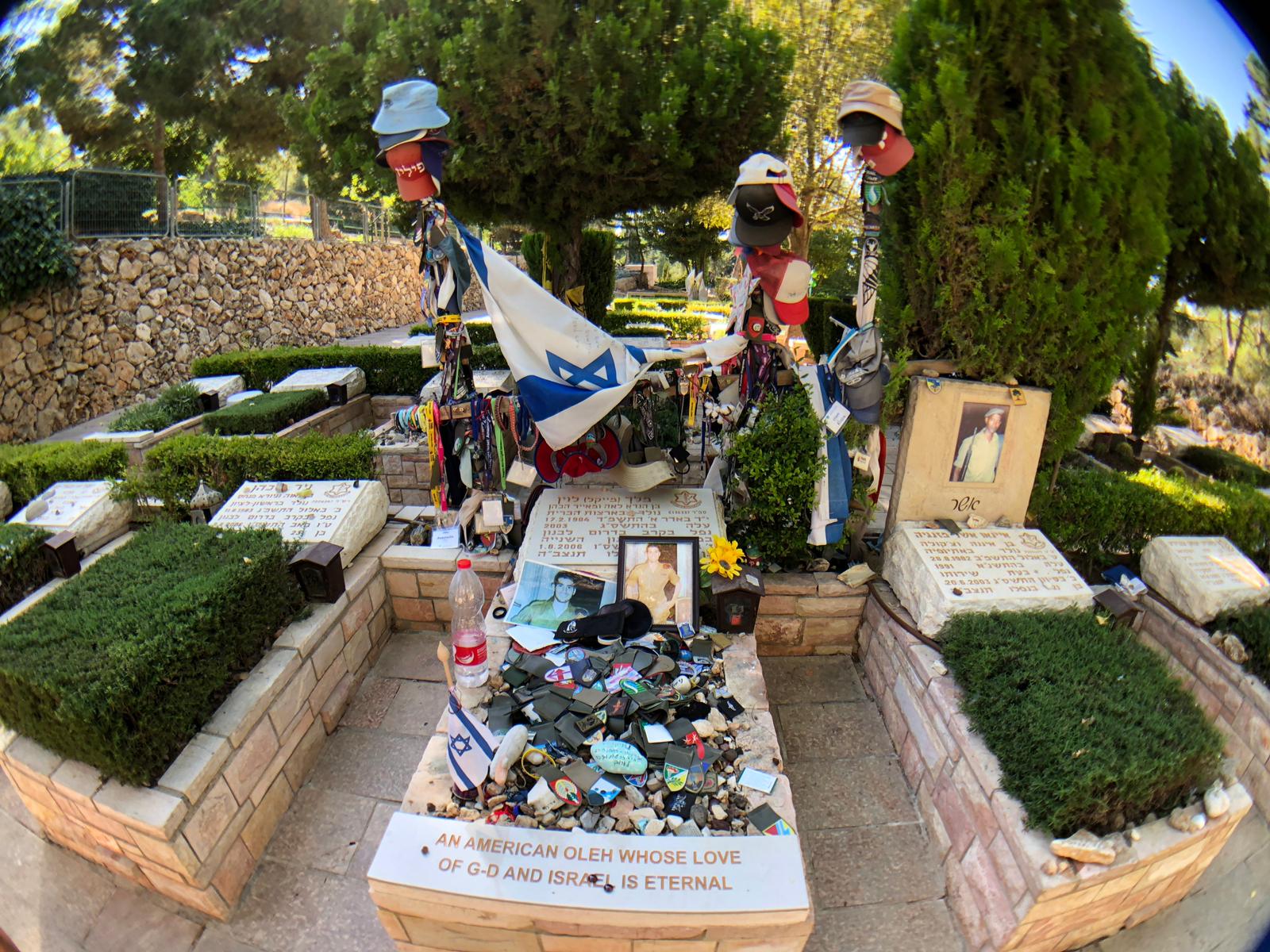
Day 10 - Farewells
As we waited at the airport to depart, Nate bemoaned that he didn’t have a book to read on the flight. Dani, who was halfway through Dan Brown’s Digital Fortress, took inspiration from King Solomon and ripped the book in half. Nate later told me that the book was really bad. In Dani’s defense, she bought it at an Israeli bookstore where there weren’t many English language options.
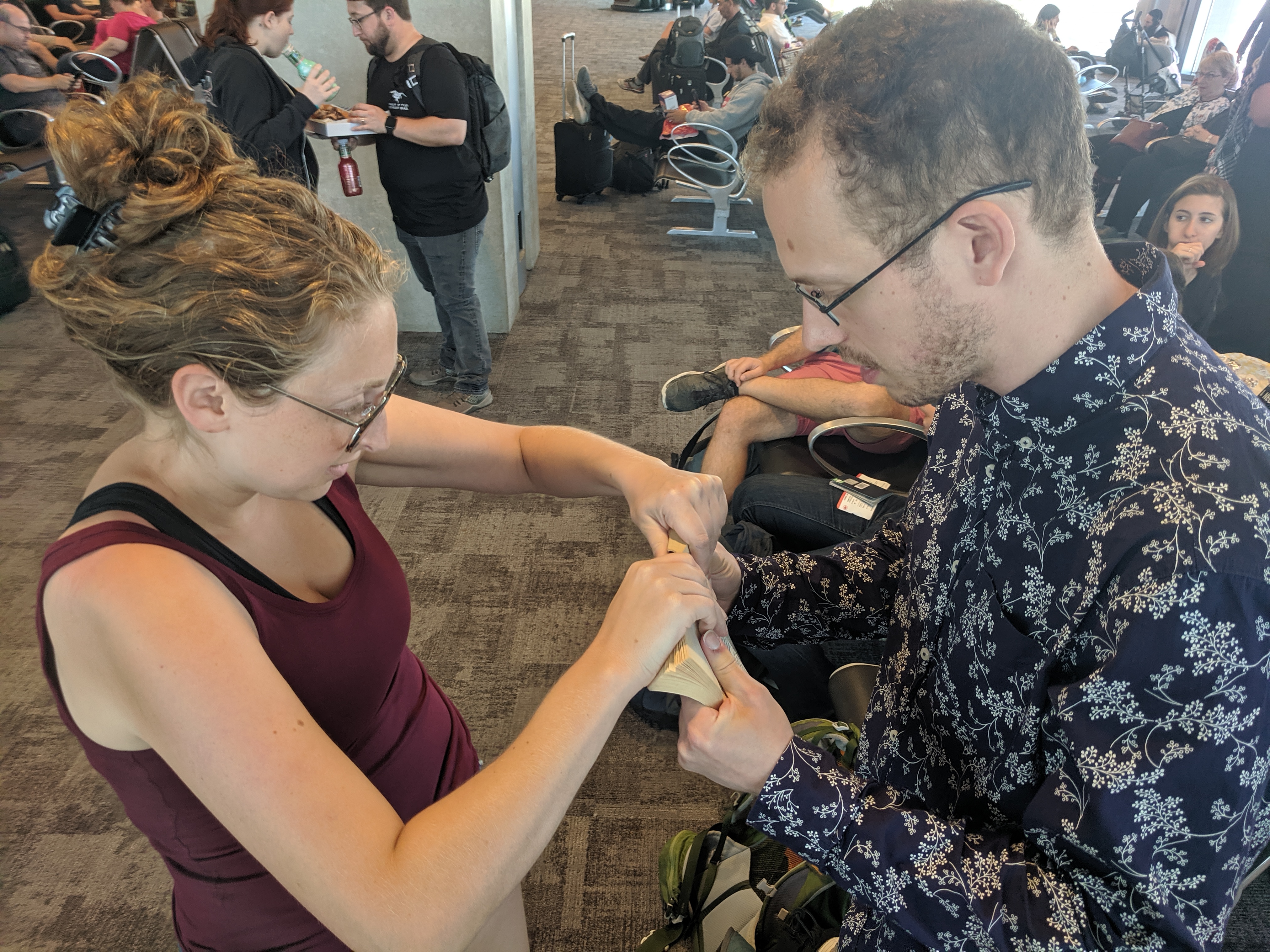
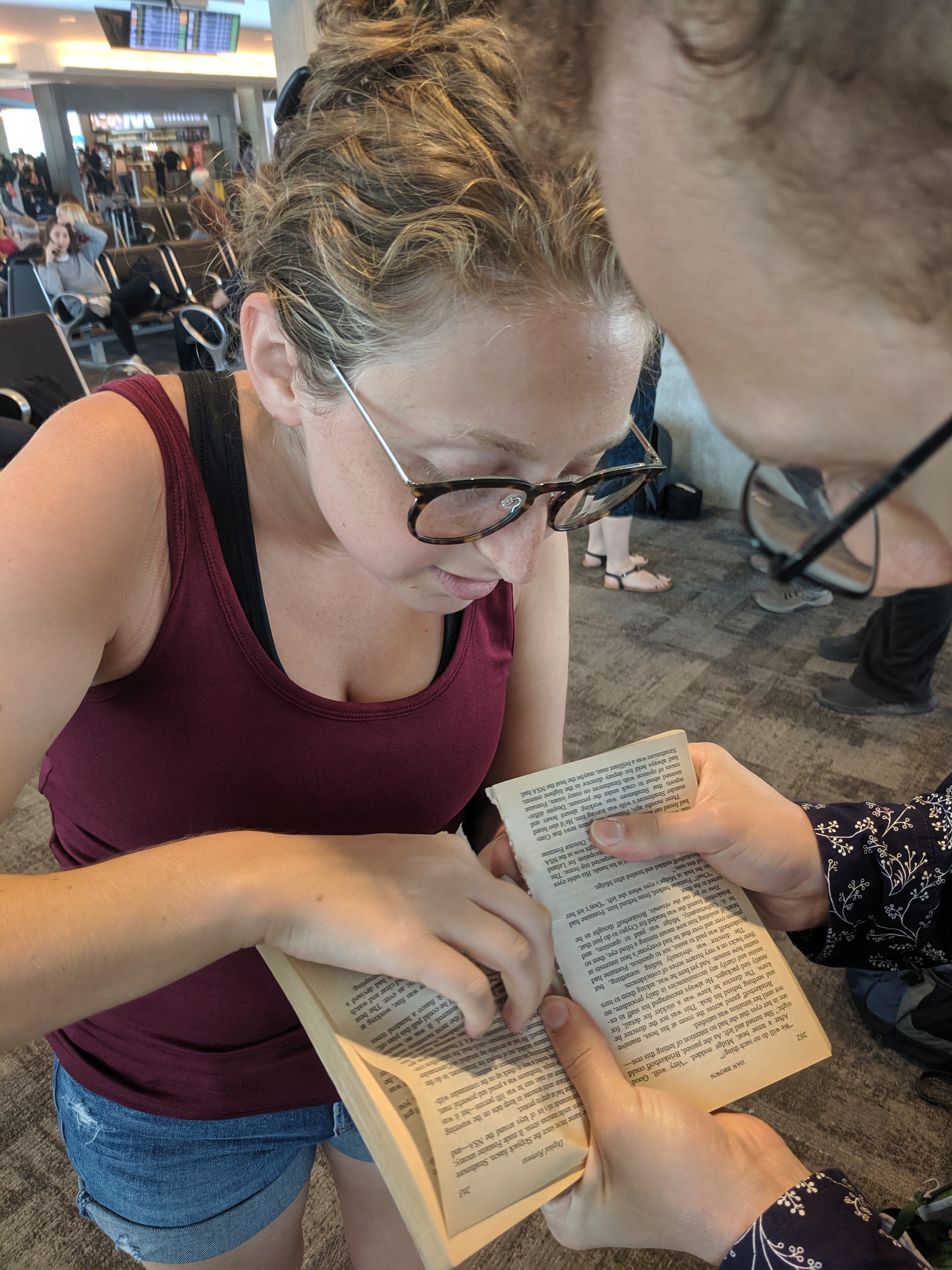
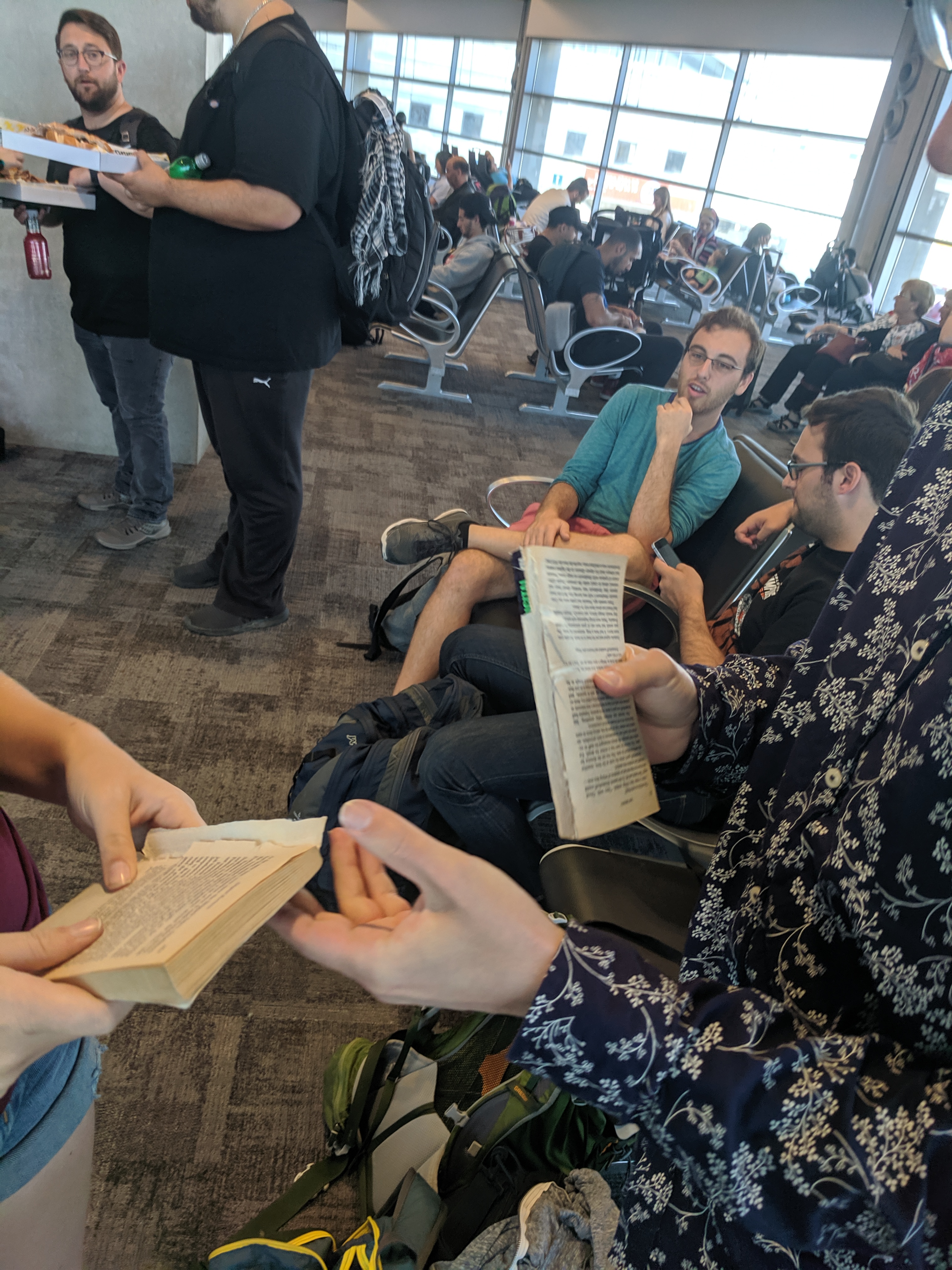
After I finally touched down in San Jose, I took an Uber home to Mountain View. My driver and I started chatting and I learned that she and her family are from Mexico, that they are deeply Catholic, and that she would love to visit pilgrimage sites in Israel someday, but she can’t because her family moved to the US illegally and if she left, she wouldn’t be able to return. Seizing the opportunity, I asked her what her opinion of Donald Trump is. She told me that she and her family are big supporters of Trump despite his immigration policy because they see him as a fellow Christian who prioritized the important aspects of society like opposing gay marriage and instituting Christian prayer in public school. The rest of the conversation was more difficult to maintain.
Retrospective
I couldn’t remember when this happened on the trip, so I decided to just put this at the end. Itamar told us many funny stories, most of which I sadly can’t remember. One that I can is the following joke. A Jew is stranded on an island. How many temples does he build, and why? Two. One to pray at, the other to never step foot in. Itamar also told us a story that I tracked down to Hillel the Elder, the namesake of Hillel International. A man came to Hillel and asked him to explain the whole of the Torah while balancing on one foot. Hillel replied, “What is hateful to you, do not do to your fellow: this is the whole Torah; the rest is the explanation; go and learn.”
One aspect of the trip that felt odd to me was the lack of meaningful music. As we traveled all over the country on the bus, people would play music from their devices, but for the most part, the songs were common and boring e.g. Elton John’s Tiny Dancer, or in Jonathan’s version, Tony Danza. But there was nothing like an introduction to Israel’s national anthem and certainly nothing that could compare to the Leonard Cohen tribute concert I attended years ago. Songs like Who by Fire and You Want It Darker could have provoked conversations about their origins and significance. For example, one of the stories I learned at the tribute concert was the story behind Lover Lover Lover. In 1973, when the Yom Kippur War started, Cohen left his home to volunteer at a kibbutz since most men had been called to serve in the war. A fan persuaded Cohen that his talents could be better used by motivating troops and so Cohen traveled around the Sinai Peninsula performing during the war. Invigorated and depressed by what he witnessed, he wrote the song of a soldier who recognizes that he has used his gift of life to destroy that gift in others and desperately begs for an opportunity to start afresh, only to be denied.
The final story I thought I’d share is the story of a young girl who traveled with us, whose life is as painful as it is inspirational. Hopefully I remember it correctly. At age 12, or perhaps a bit earlier, she began experiencing tremendous pain on her side. Being an athlete in soccer and gymnastics, her doctors thought the cause was likely something transient. But she insisted that something was wrong, even as more and more tests were conducted. It wasn’t until her physical therapist ordered a CT scan that someone noticed something strange poking out from under her ribs. The first diagnosis was an aggressive, malignant form of cancer that, had she had it, would have likely killed her. But as the doctors investigated further, they narrowed her diagnosis down to a rare form of cancer that had fewer than 400 recorded cases in humanity’s medical history. The cancer had grown like a hand on the inside of her ribcage, sending fingers to wrap around her ribs. In the ensuing years, this girl lost two ribs, underwent chemotherapy at least twice, suffered a collapsed lung multiple times including once where the doctors accidentally nicked her lung during an operation and didn’t notice until she came back hours later, gasping for air. But thankfully, her cancer stopped growing and she was able to attend a good university. I wondered whether her experiences had given her a greater appreciation for the fragility and shortness of life. Her answer, that she now gets high every night on THC concentrate, not for her pain nor for her appetite, but out of boredom, gave me a glimpse at the answer.
tags: travel - 2019 - israel - judaism